Update: Growing papayas in Texas has ended in disaster. During the week of February 15th, we experienced a record cold snap along the upper coast. This week’s winter storm, by the numbers:
Coldest recorded temperature this week: 13 degrees on Feb. 16
Longest stretch of freezing temperatures: 44 consecutive hours from 6:53 p.m. Sunday to 1:53 p.m. Tuesday
Normal average temperature on Feb. 15 in Houston: 56.4
Average temperature Feb, 15, 2021: 20.5 (difference of 35.9 degrees)
The trees were devastated by the hard freeze and I have cut them off to the ground. I doubt they will recover, but I have seeds and am willing to try again!
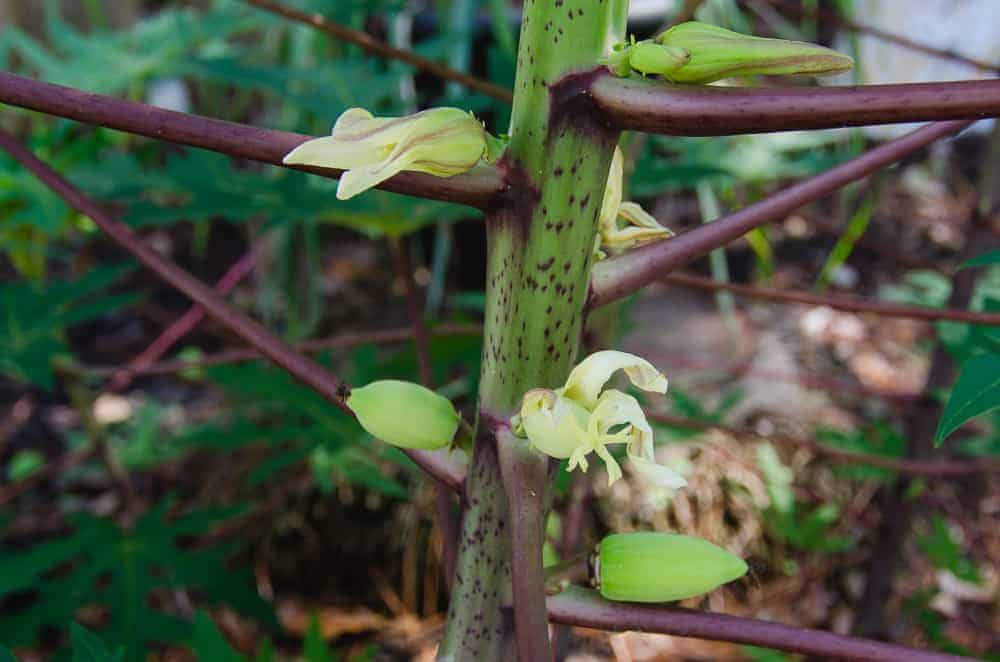
Growing papayas in Texas can be a challenge! However the experiment has been interesting and entertaining. My experience had a casual beginning but became a fun and educational project.
Living near the Gulf coast reduces winter impact, however winter temperatures will be the major obstacle to my success. Papayas love warm temperatures, abundant sunshine and adequate rainfall. We have that for most of the year.
Papaya (Carica papaya L. ) is one of my favorite fruits. Refreshing, healthy and delicious. Early in the summer of 2019, I picked up a nice ripe Maradol papaya from the grocery store. While cutting, I noticed that many of the numerous seeds had already begun to sprout. Then I tossed a handful into a flower pot just outside on my patio.
After a few weeks, the seeds grew into small seedlings. Papayas are sensitive to transplanting, therefore I carefully took the 3″ seedlings to a raised bed. With abundant Texas sunshine and adequate water, the seedlings soon became rapidly growing papaya trees. Because papaya trees have long tap roots, I needed to put them in the ground. Although the risk of a winter freeze is always a concern, planting them was the only plausible way to produce fruit. I planted 9 good seedlings from the raised bed into the ground.
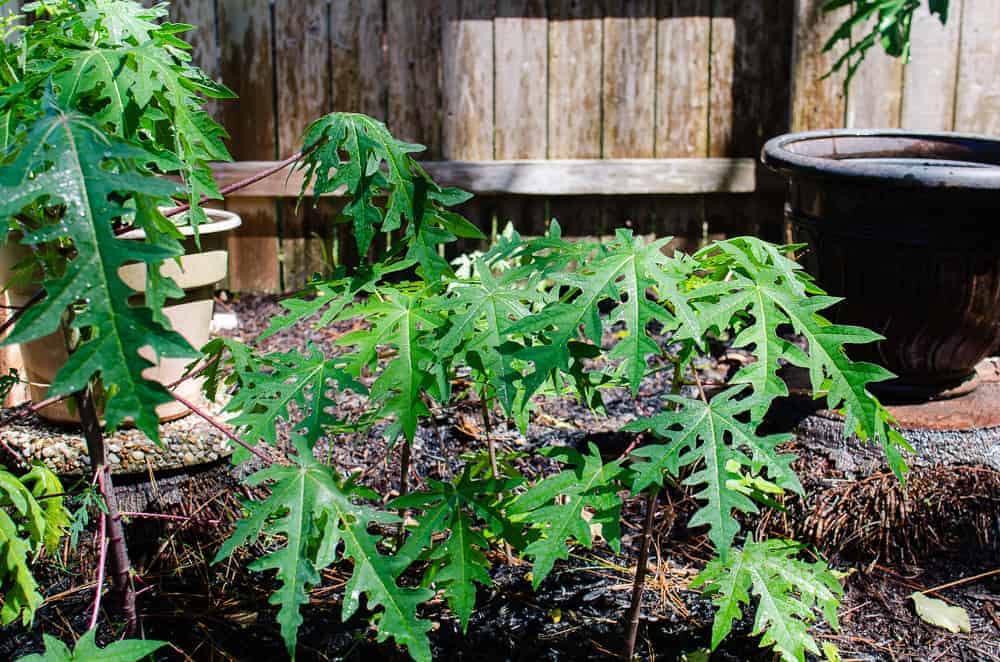
Papayas are rapid growing and soon many of my seedlings were strong healthy and putting on height. When one of the trees reached a height of about three feet, flower buds sprouted at the base of the leaf axils. (the upper angle between a leaf stalk or branch and the stem or trunk)

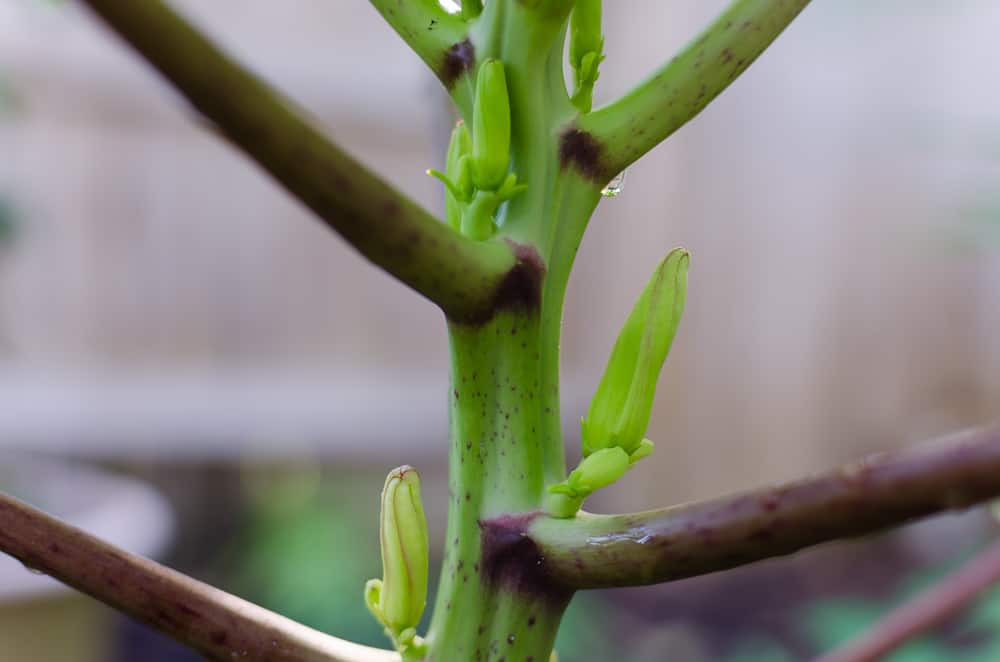
Papaya Sex Determination
While doing research on care of papaya trees I learned papayas have a complex and interesting sexual distribution. There are two main types of papaya plants. Dioecious and gynodioecious. Dioecious papayas have male and female flowers on separate trees. Gynodioecious papayas bear female flowers on some trees and bisexual (hermaphrodite) flowers on others. As a result fruit production in papaya plants can occur through cross-pollination, self-pollination or reproduction in which fruits may be produced without fertilization.
There are 3 basic outcomes.
- Female trees – Produce female flowers only and require a pollinator to produce fertile fruit.
- Male trees – Produce clusters of male flowers at the end of stalks. They do not produce fruit except on rare occasions.
- Hermaphrodite trees – Produce “perfect” flowers, IE. flowers that have both male and female parts and are self pollinating and produce fertile fruit.
Each type of flower is unique in its appearance. I don’t have any male plants, so no pictures of them. However below are early stage and blooming pictures of the female and hermaphrodite flowers.
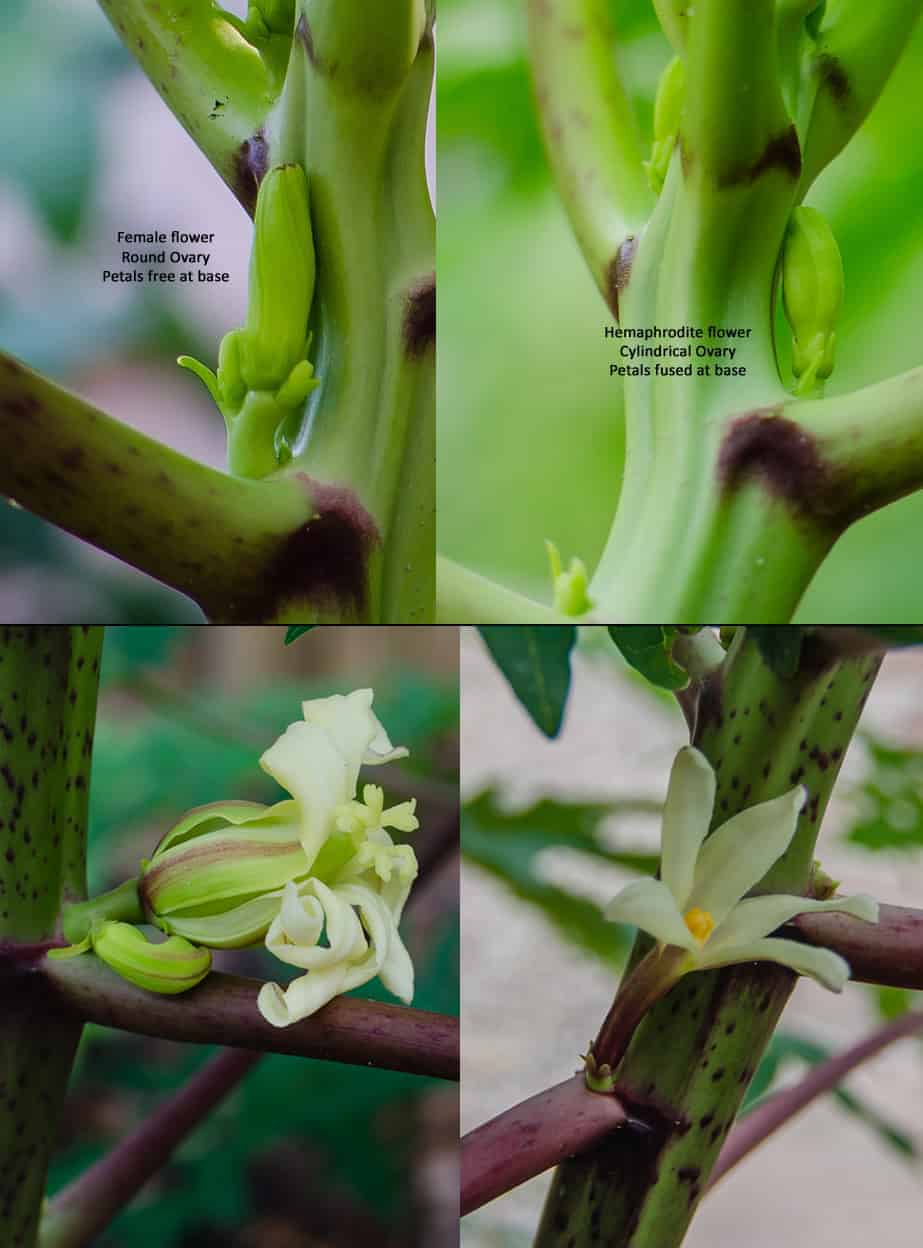
The sex of papaya trees cannot not easily be determined until they begin to flower.
My seeds came from a commercially produced papaya. Therefore I presumed that the growers would cull male trees and only cultivate females or hermaphrodite trees. This would affect the determination of the sex of my seedlings.
Papaya Genetics
Seed sex from papaya is determined as below:
Hermaphrodite papaya trees are primarily self-pollinated.
- Seeds from self pollinated Hermaphrodite trees always segregate into hermaphrodites and females at the ratio 2:1.
- Seeds from female trees segregate: If they were fertilized by pollen from a hermaphrodite tree – Hermaphrodite to female ratio of 1:1 or If fertilized by pollen from a male tree – A ratio of 1:1 male to female.
- Male trees are never produced when hermaphrodites are self pollinated or when hermaphrodites are used as a pollen source to fertilize female trees. However, male trees occur at a ratio of 2 male:1 female when the occasional male fruit is self pollinated or 1 male: 1 hermaphrodite: 1 female when male pollen fertilizes the pistil of hermaphrodite trees.
These ratios have been studied and documented.
Papaya Flowers
When the flower buds reach a length of about 1″ it becomes possible to differentiate between female and hermaphrodite trees. Males flowers are readily discerned from pistillate flowers by their long stalk and clustered appearance.
The preference for successful fruit production is to have all hermaphrodite plants. I had no idea of how the sex distribution of my trees would turn out. However the first tree to flower was clearly a female with no pollinators in sight.
This female was also the largest of my trees and began to produce a steady stream of flowers. Without pollination fruits may tend to drop. In my case it seems as though some of the fruits may develop into seedless papayas.
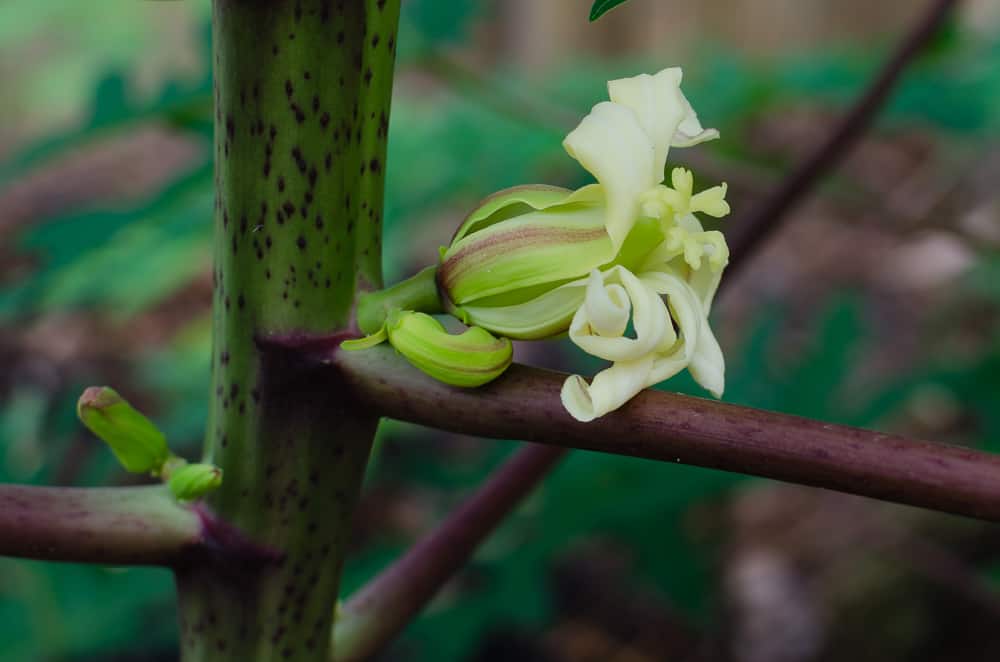
Over a period of a few weeks in late summer, four other trees began to produce flower buds but they were too small at that point to determine sex.
Finally in early November a flower opened that was clearly a hermaphrodite. This single flower may self pollinate and may provide some pollen for the female neighbor. At this time none of my plants have produced any male flowers.
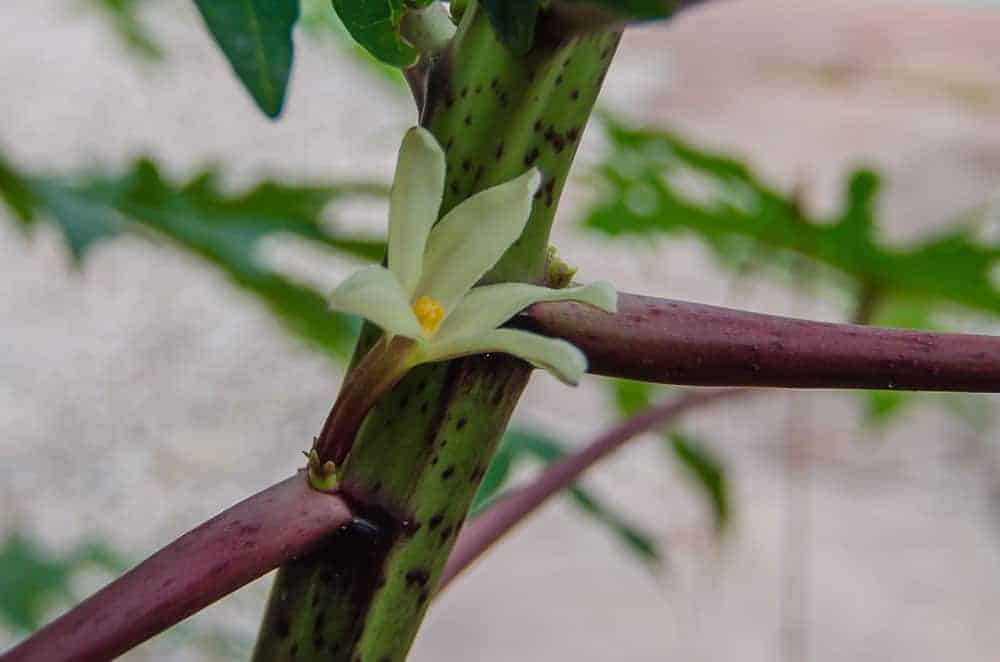
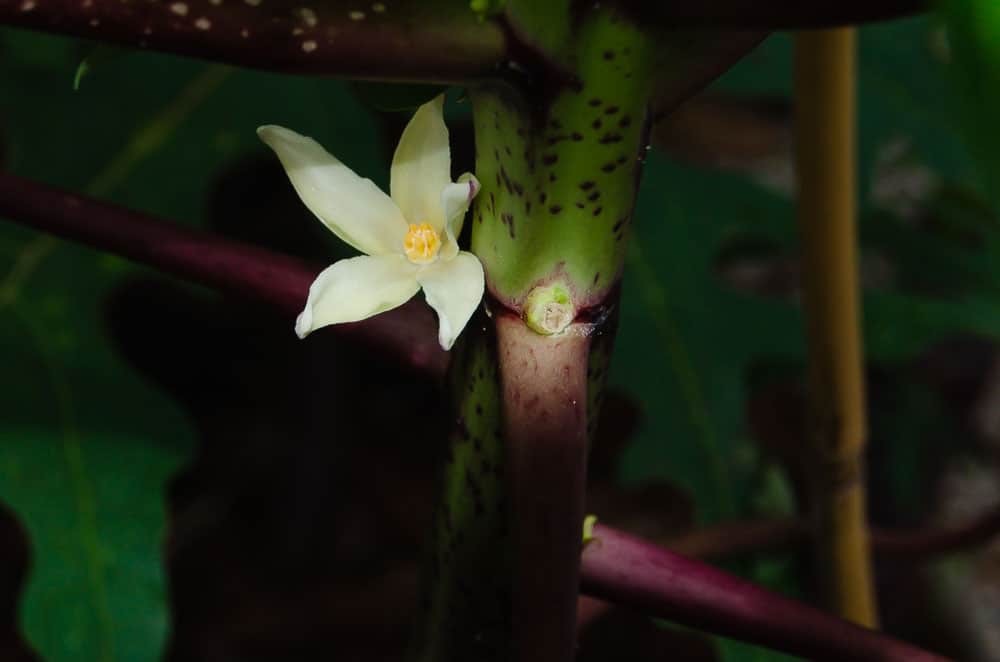
Growing Papayas in Texas Winter Challenge
Growing Papayas in Texas can take many months. The fruits are ready to harvest five to six months after flowering, which occurs a few months after seed germination. To be successful, my trees need to survive the winter. Papaya is a tropical and success in growing Papayas in Texas is subject to the severity of the winter. My research revealed minimum temperatures below 10º C (50º F) significantly affect pollen viability and quantity produced. However the receptivity of papaya stigmas remains high throughout the year. If pollinated with viable pollen, both female and hermaphrodite flowers can successfully produce fruit, even in winter.
Being a tropical, papayas rarely survive freezing temperatures. Much to my dismay, the weather forecast for mid November called for an unseasonable freeze warning. Therefore I decided to take action to protect the trees from a forecast of 31º F. Enclosing the trees in a mini “greenhouse” with a heat producing halogen work light was my plan.

The cold night came and went. However the temperature stayed just above the freezing mark. In a few days I should know if there is any damage to the trees but they currently look good. The temperature is in the mid 50’s today with no freeze or frost warnings in sight. I have every intention to protect my trees from further inclement weather. Survival through the winter will give the my fruit crop a great head start in the spring. Check back periodically for updates on my Growing Papayas in Texas journey.
In addition to the flowering plants in the ground, I have planted seeds from the Royal Star variety. I also acquired these from a store purchased papaya of excellent quality and sweetness. You can find out more about the Royal Star here.
Texas Papaya Flowers and Fruits
The weather has been seasonal since my original post. The “mini greenhouse” is still in place. I placed a thermometer inside my enclosure. On sunny days, with an air temperature in the mid 60’s, the temperature in the enclosure reaches the mid to upper 80’s. The Papayas seem to be getting enough sun. As a result they and are putting on more fruits and flowers. Some of the fruits are fat and about 2″ long. I seem to have one female and three hermaphrodite trees at this point. If I can get through the winter, fruit will be on the menu!
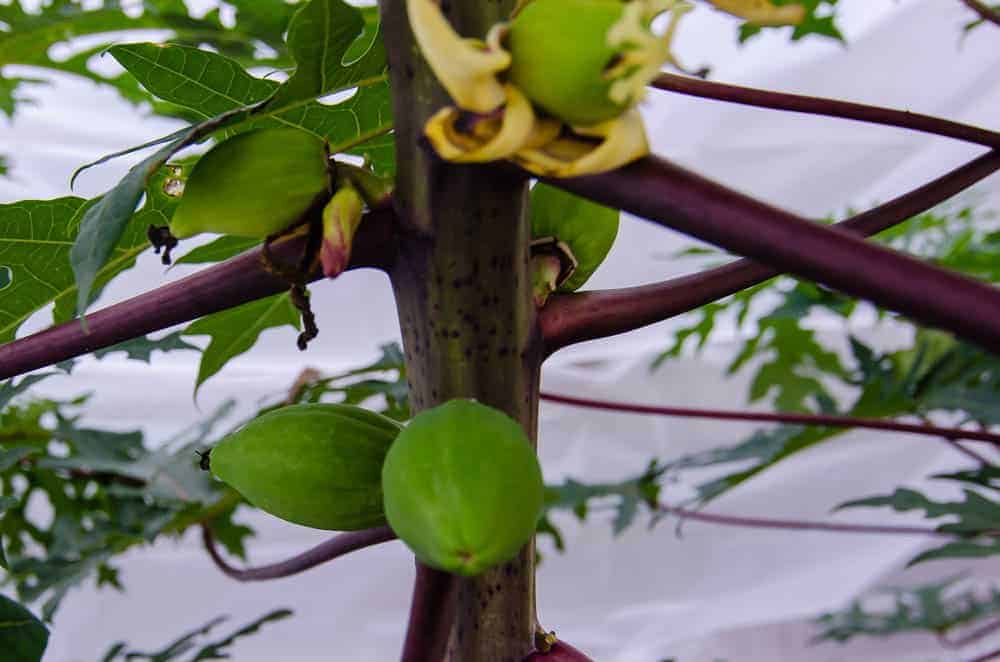
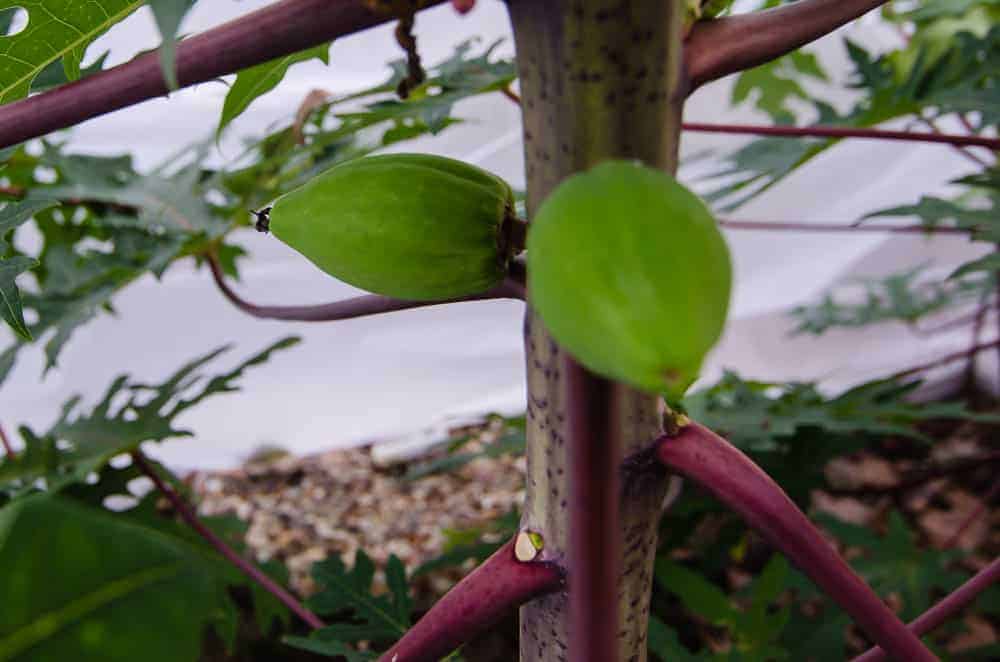
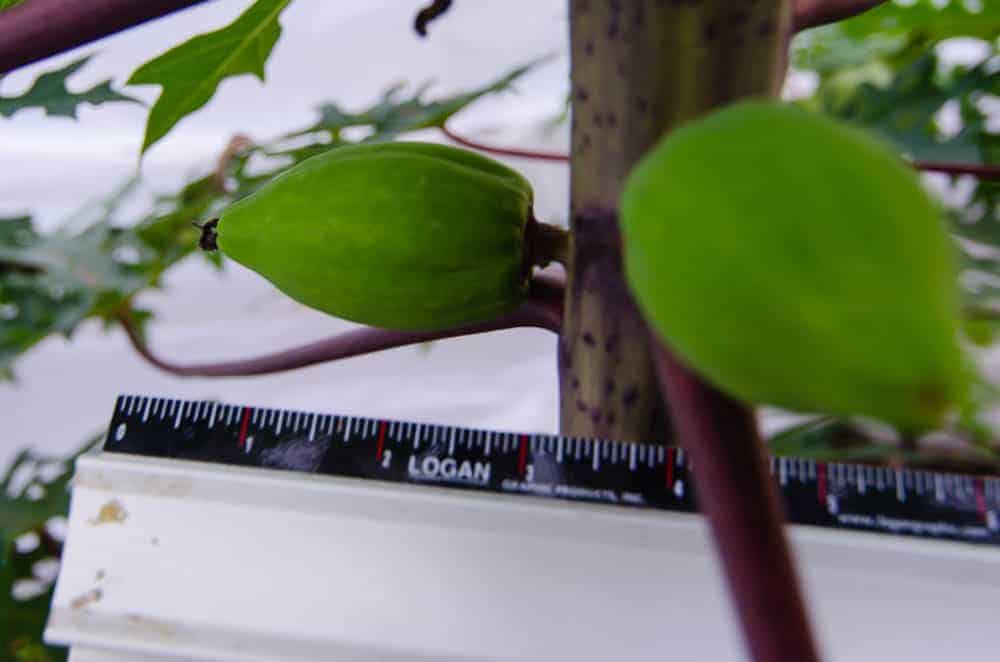
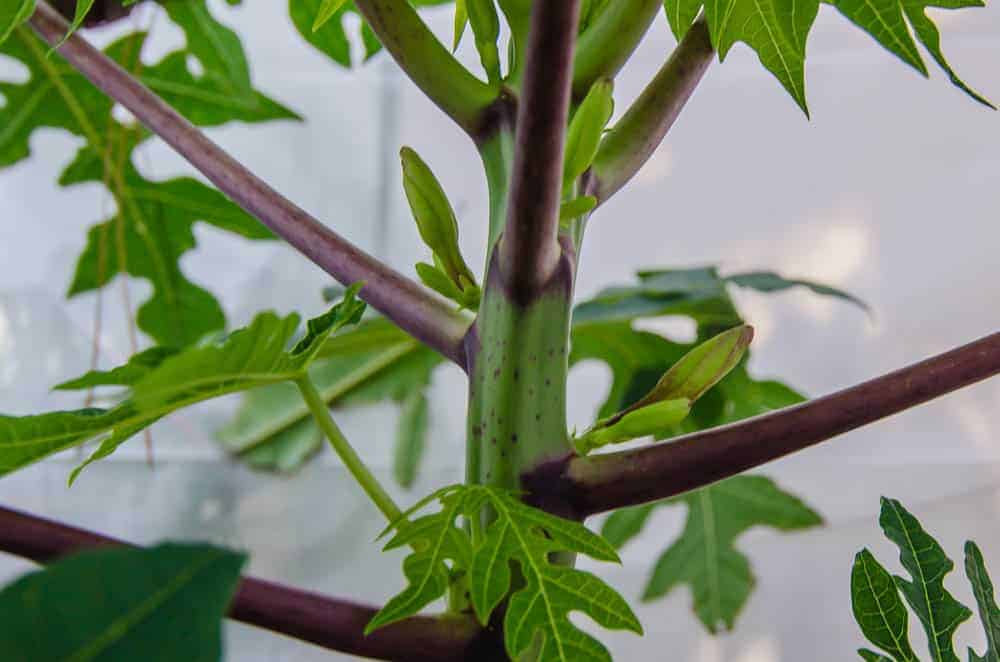
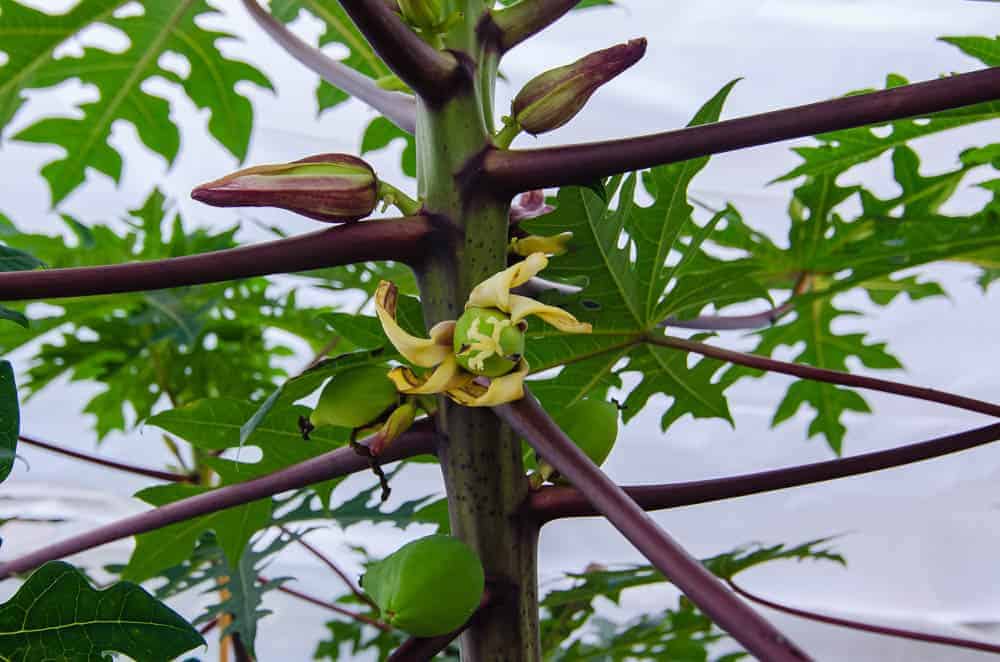
The weather is still mild with some days reaching 80 degrees F. The plants look healthy with more flowers opening.
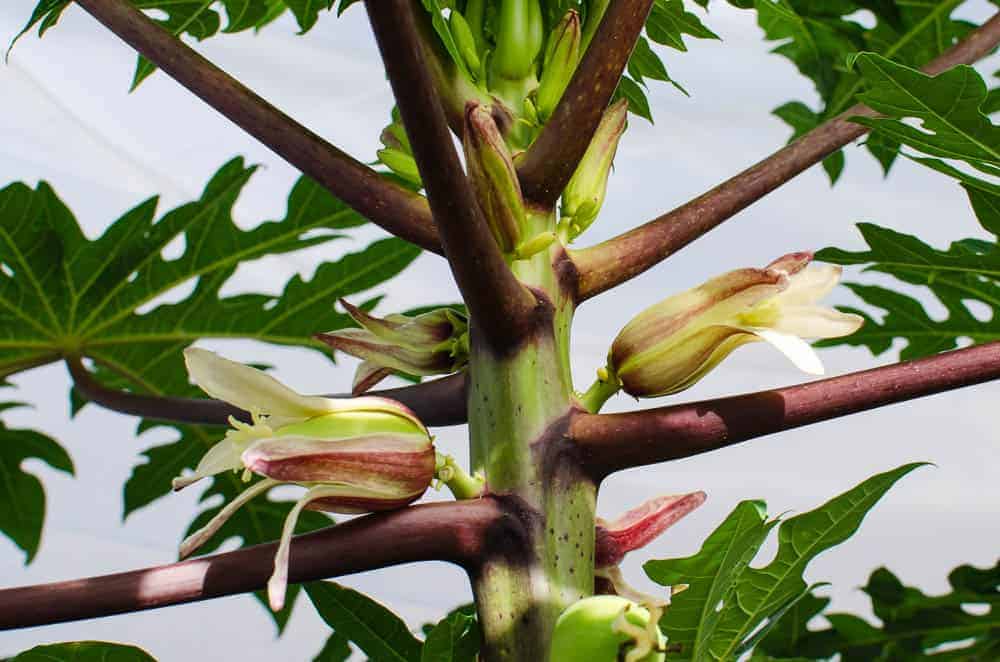
Growing Papayas in Texas Update: Christmas Eve, 2019
The weather has cooperated during December. The coldest nights have barely reached the low 40’s and the plants are doing well. They continue to flower. Some questions arise about some of the flowers that I previously identified to be hermaphrodites. As they continue to develop I should be able to confirm their orientation. I believe they are hermaphrodite plants, however they are bearing female sterile flowers. This results in single flowers with non functional ovaries at the leaf axils. The daytime temperature in my enclosure today was 86 F at 14:00 hrs. The ambient air temperature was 68 F.
Spring comes early in coastal Texas. After early February the temperatures begin to rise. Then I will need to open the enclosure on warm days. By the end of February, freeze and frost chances plummet. Finally after early March, the chance are negligible.
Additionally, the Royal Star seeds (below) have germinated and I will get them in the ground as early as possible this spring.
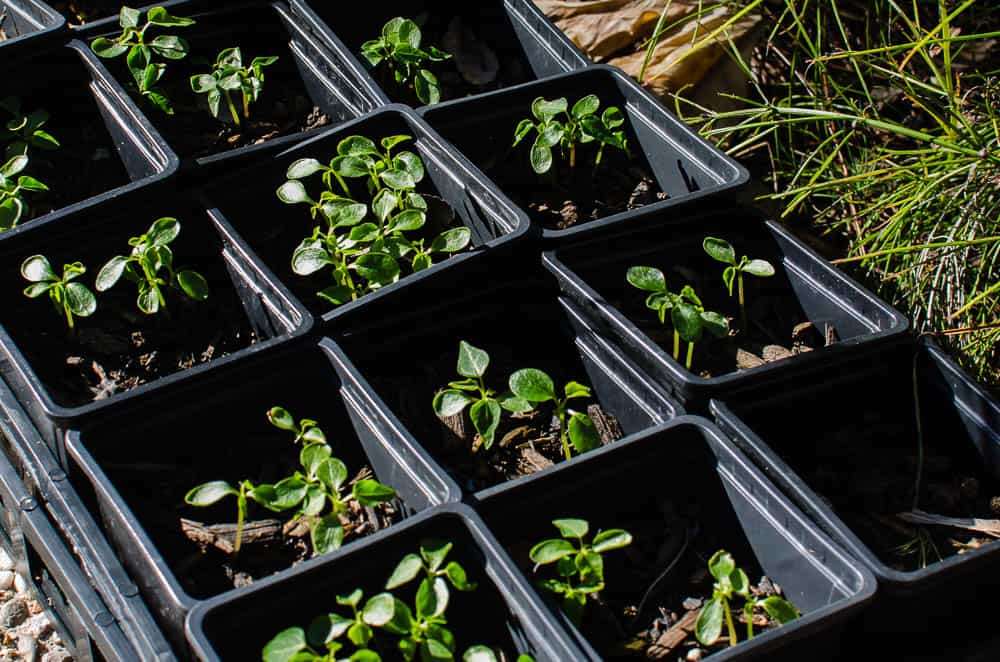
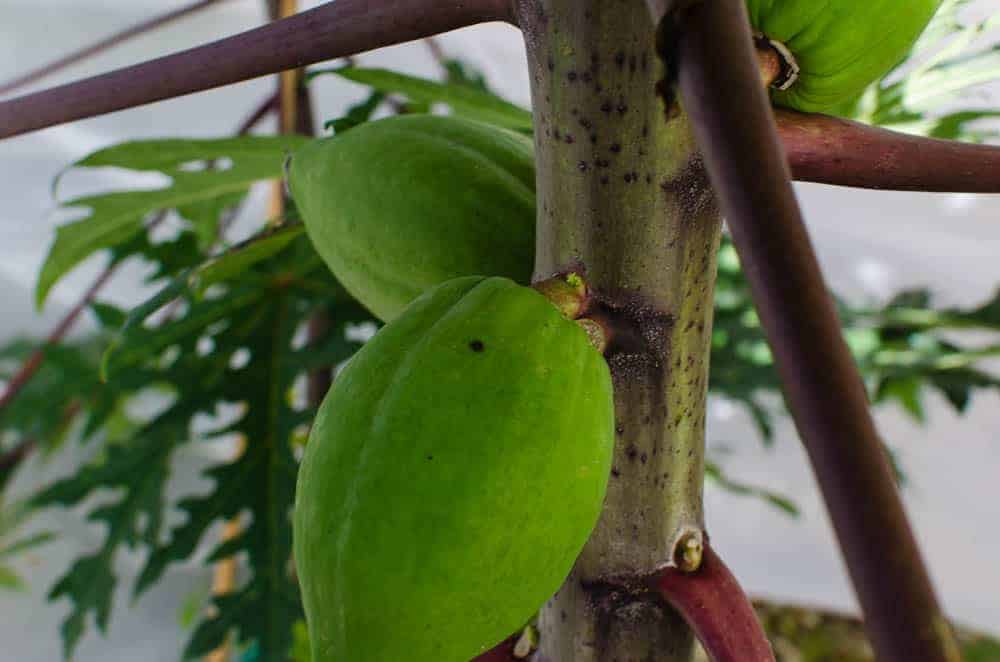
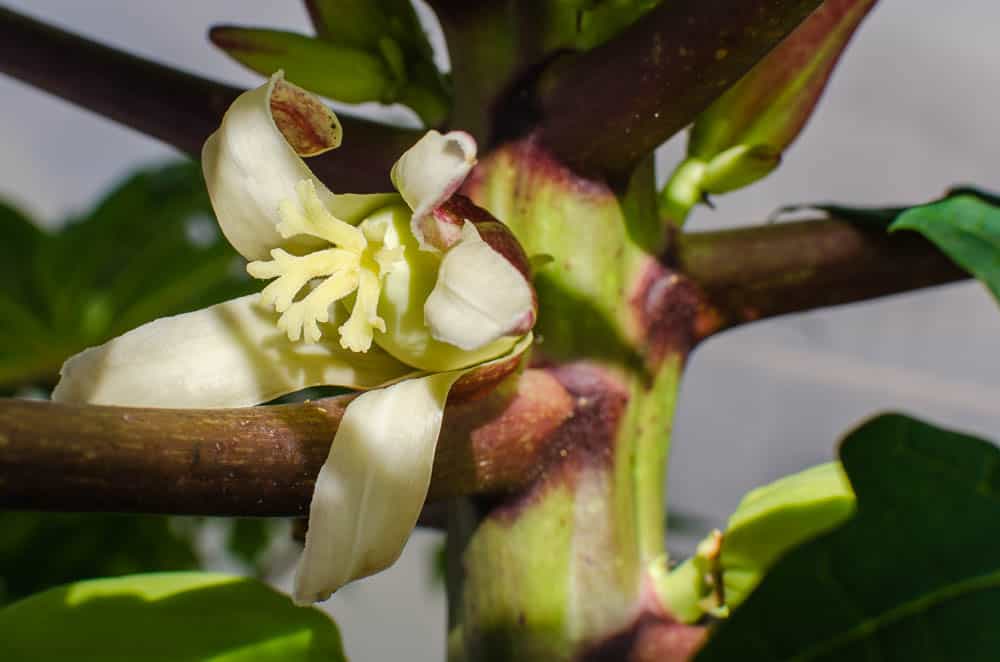
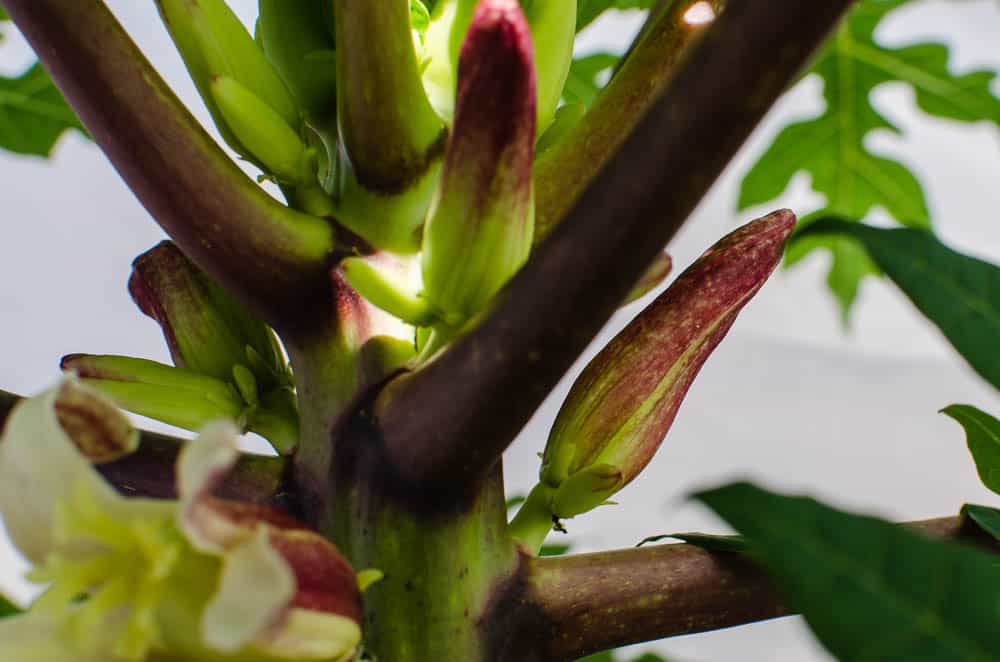
Growing Papayas in Texas Update: January 24, 2020
January is almost ended. We have been fortunate to avoid any low temperatures below the 40 degree mark. My trees are happy, growing and putting on more fruits and flowers.
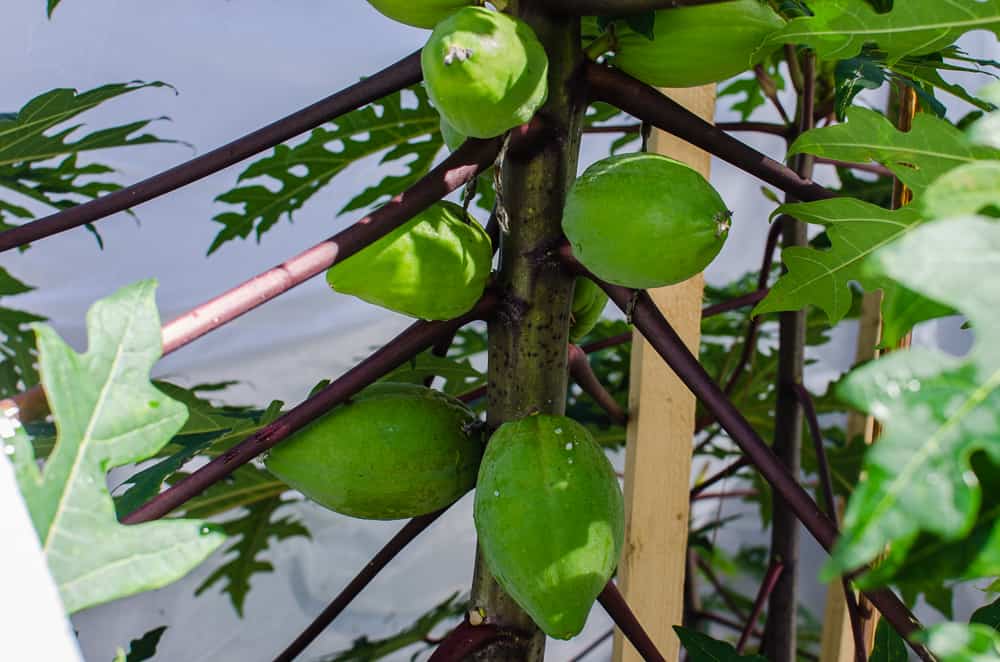
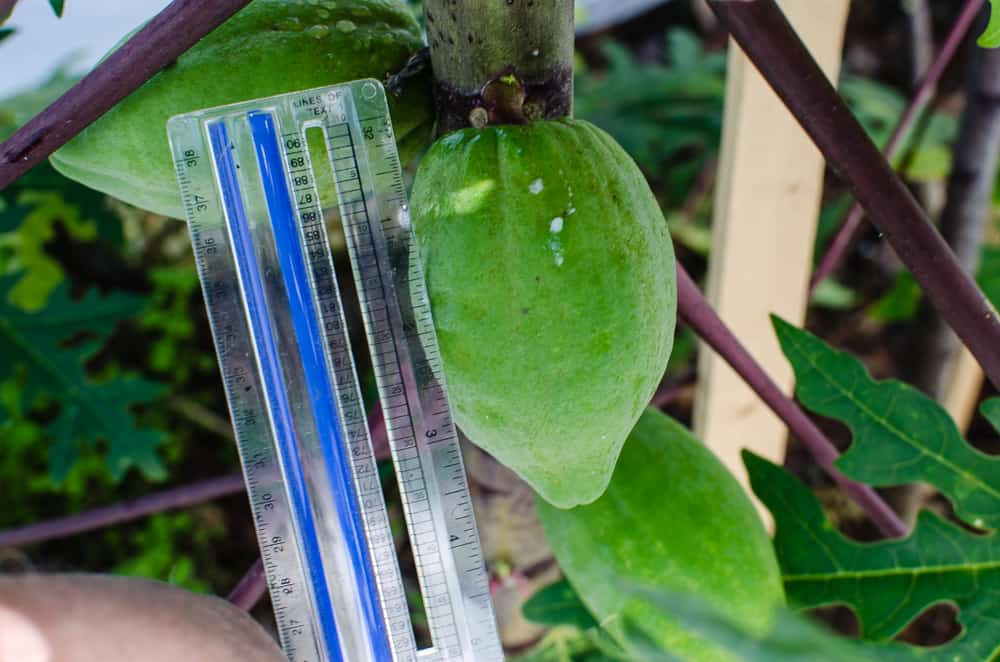
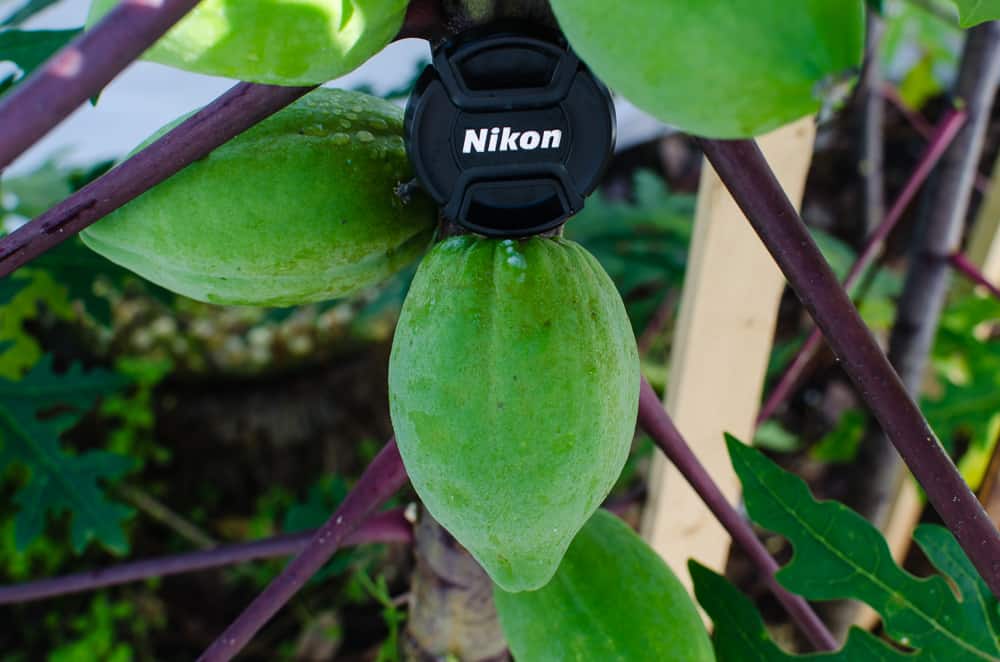
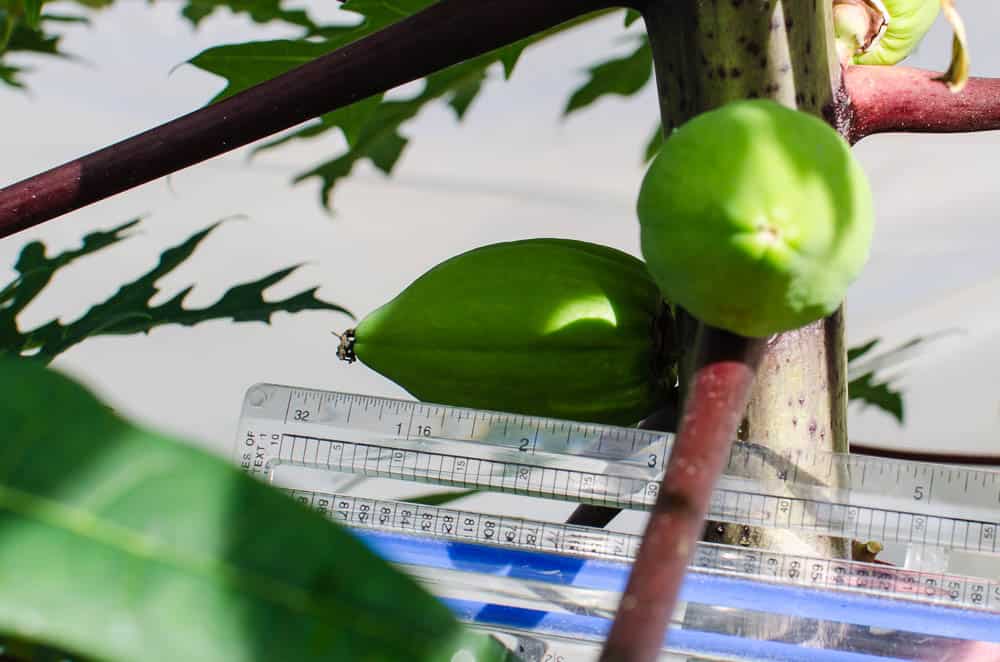
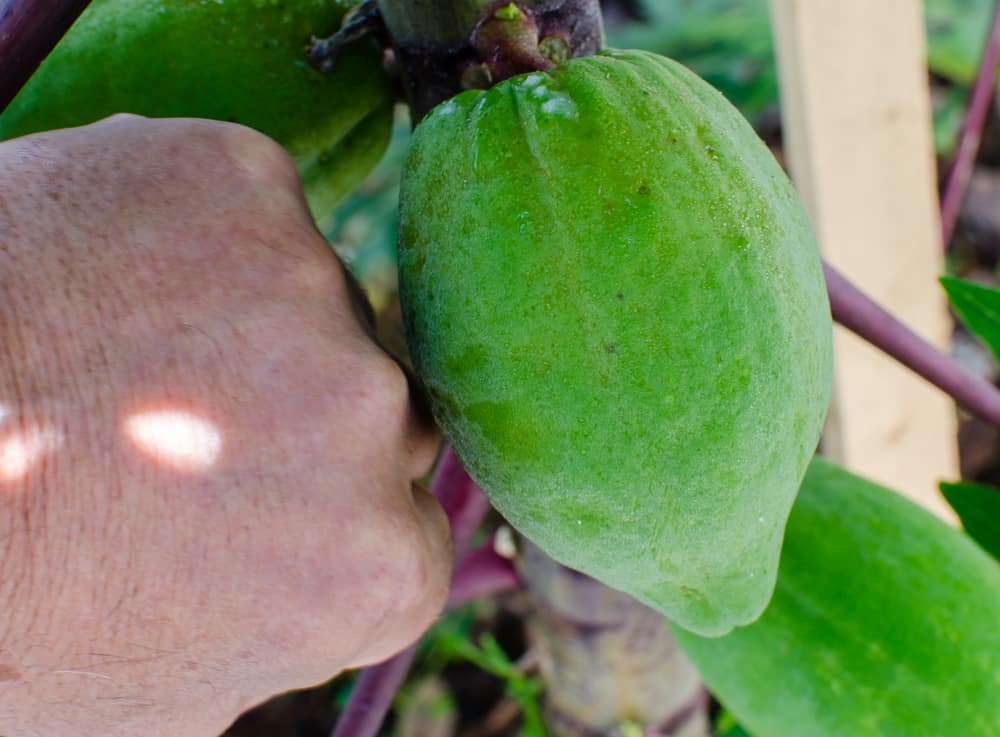
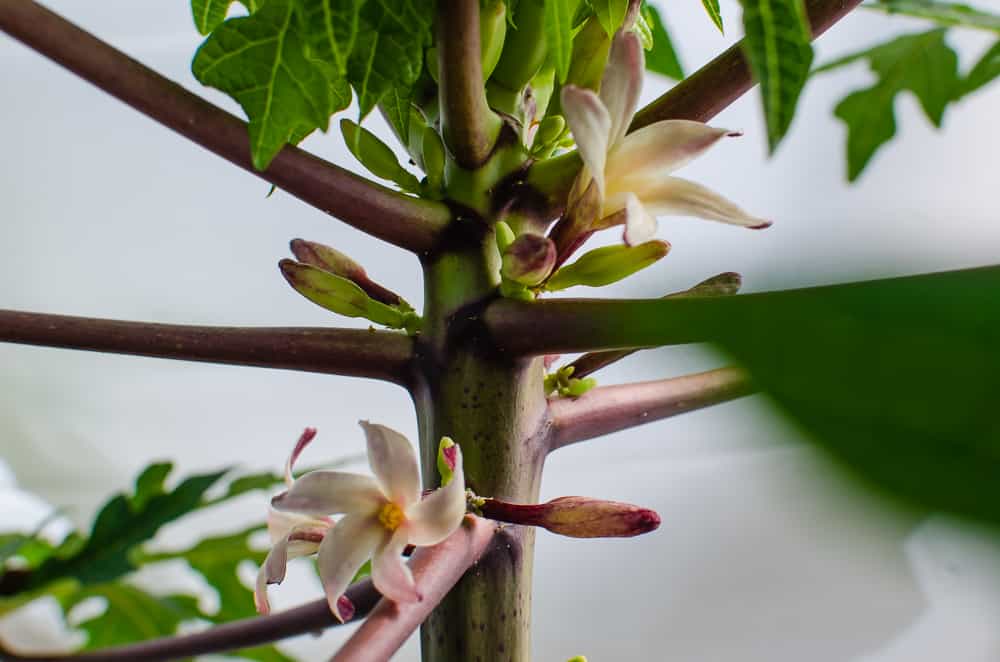
As a side note, my lemon tree is coming into bloom. The bees are doing their work.
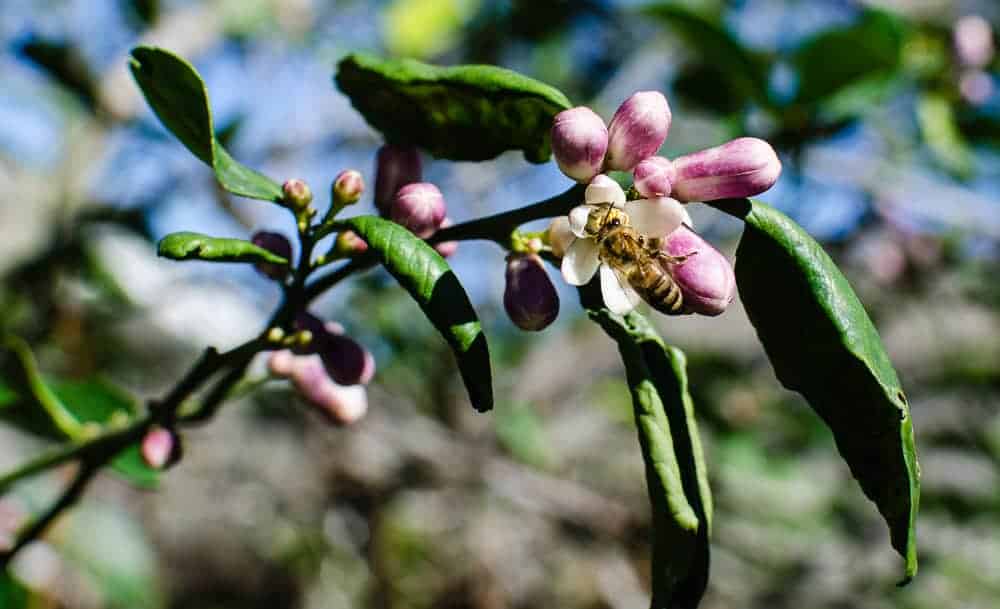
Growing Papayas in Texas Update: February 13, 2020
We’re halfway through February. Temperatures have been seasonal. The overnight lows have not dropped below the 40 degree mark. My trees are happy, growing slowly and putting on more fruits and lots of flowers. It looks like one of the plants that seemed to be a hermaphrodite had only been producing female sterile/male flowers. However the tree has now produced a perfect flower, IE one with both stamens and a functional(?) pistil. The flower is fully open so I’ll know pretty quick if it pollinates.
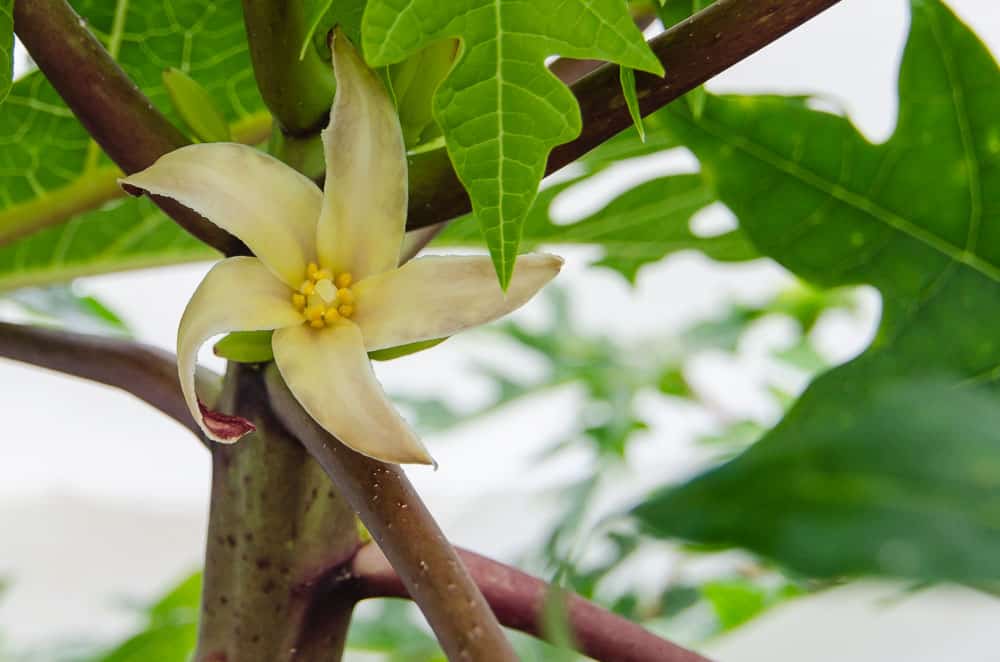
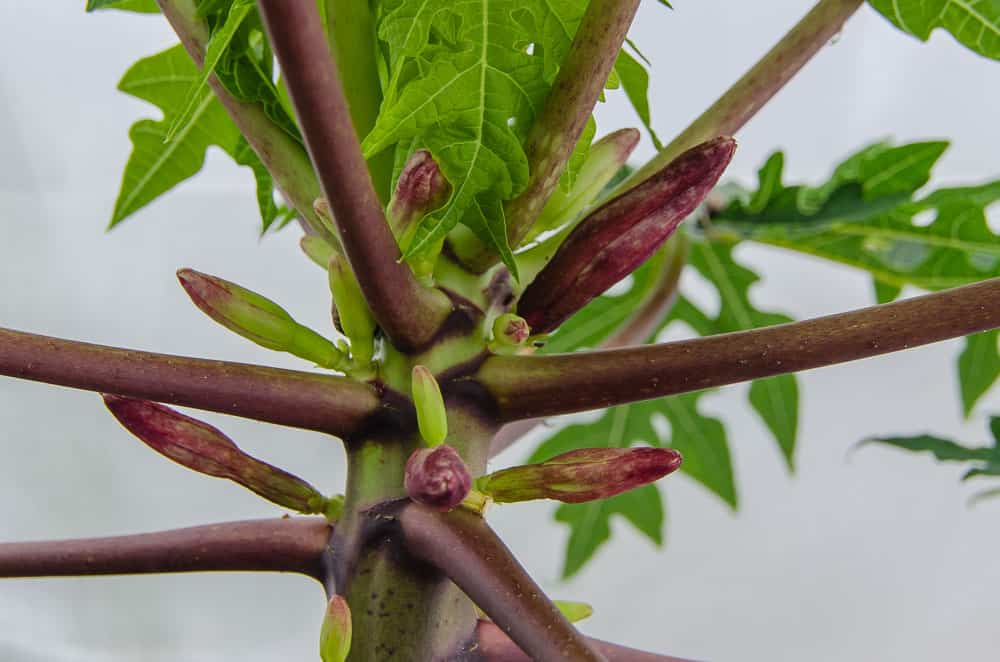
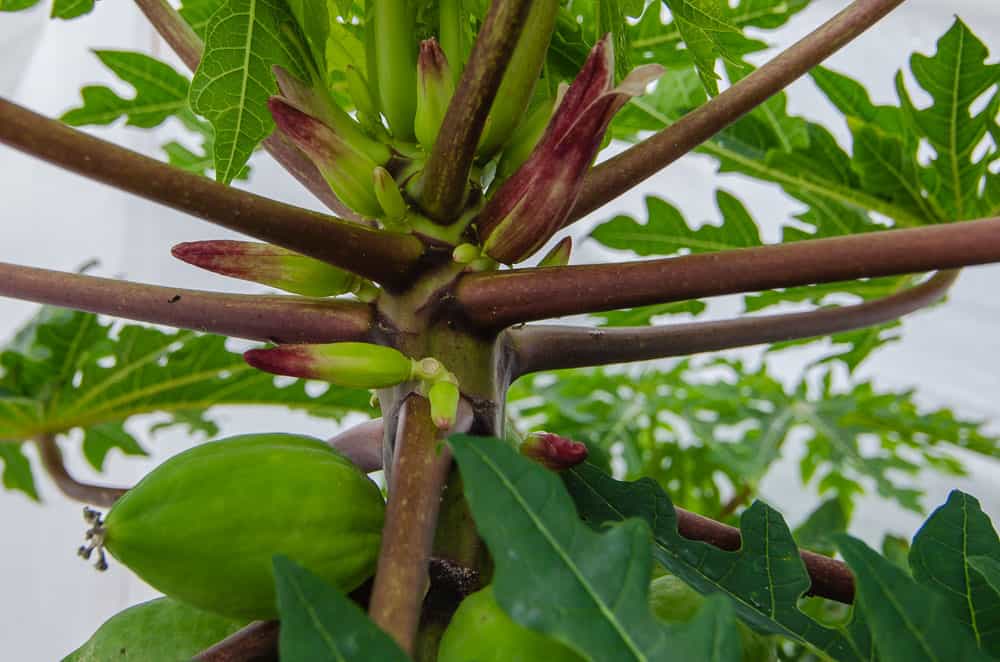
As a side note, the Texas Mountain Laurel is just beginning to bloom
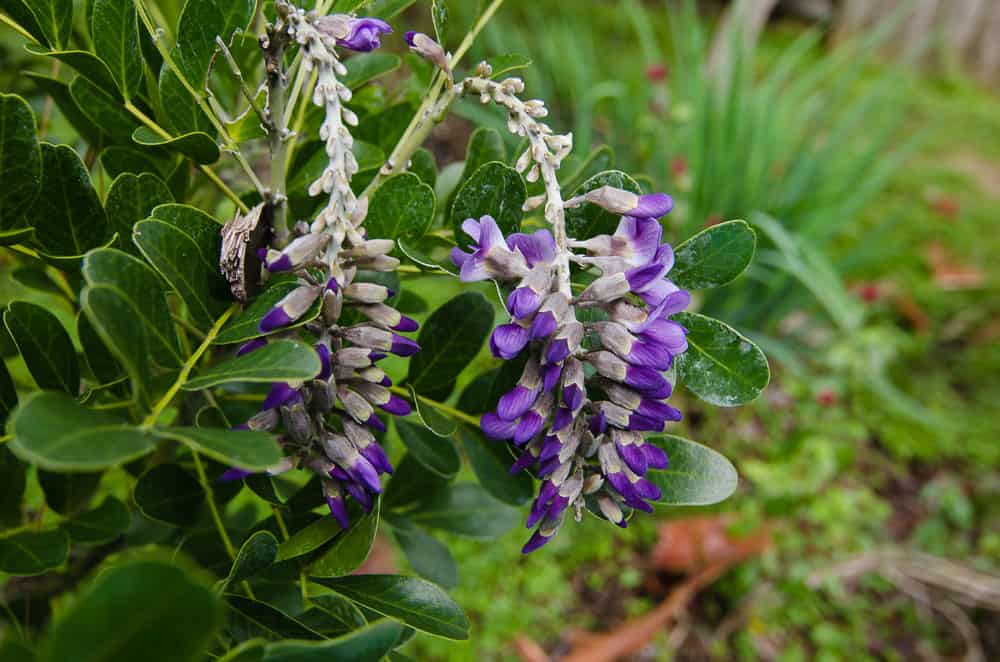
Growing Papayas in Texas Update: February 18, 2020
The past few days have seen temperatures in the mid seventies. Multiple flowers have opened since my last update. Papayas flowers are fascinating! To date, I have seen no fewer than four different displays of flower morphology. Today I can confirm the trees that had been producing female sterile perfect flowers have morphed. I now have two distinctly different “perfect” flowers on two different plants. The early versions had diminished stigmas. In addition to the new perfect flowers, there are also still female sterile flowers on the same plants. These changes are probably related to changes in day length and soil/air temperature.
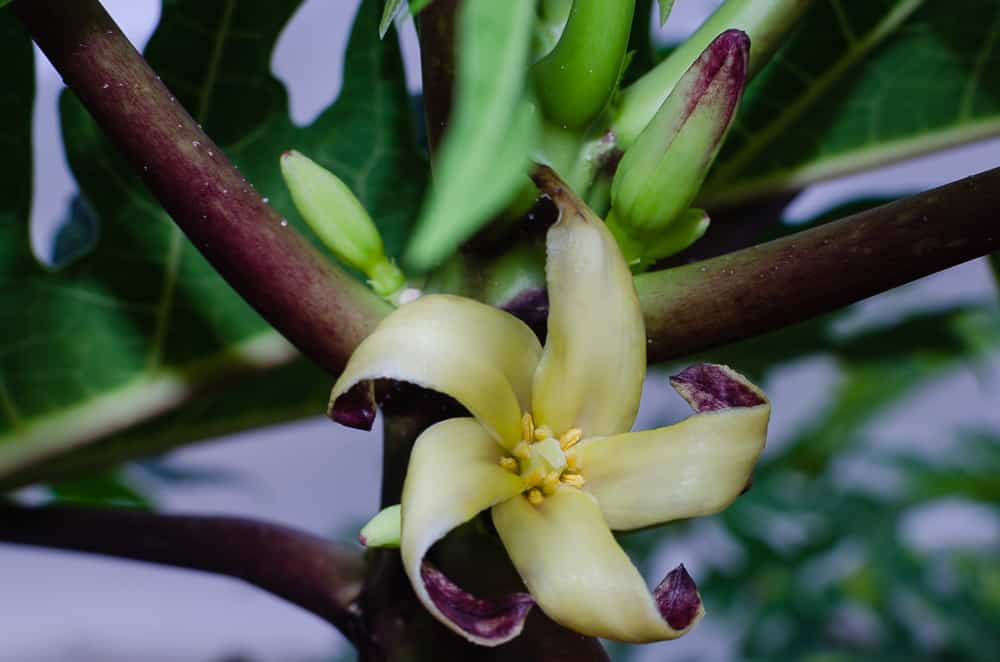
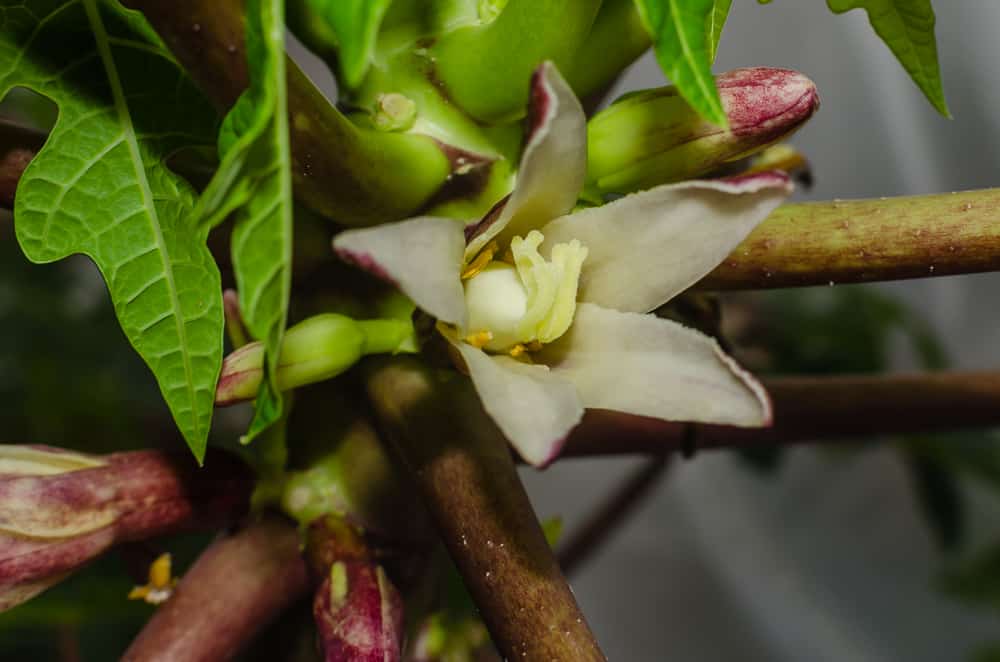
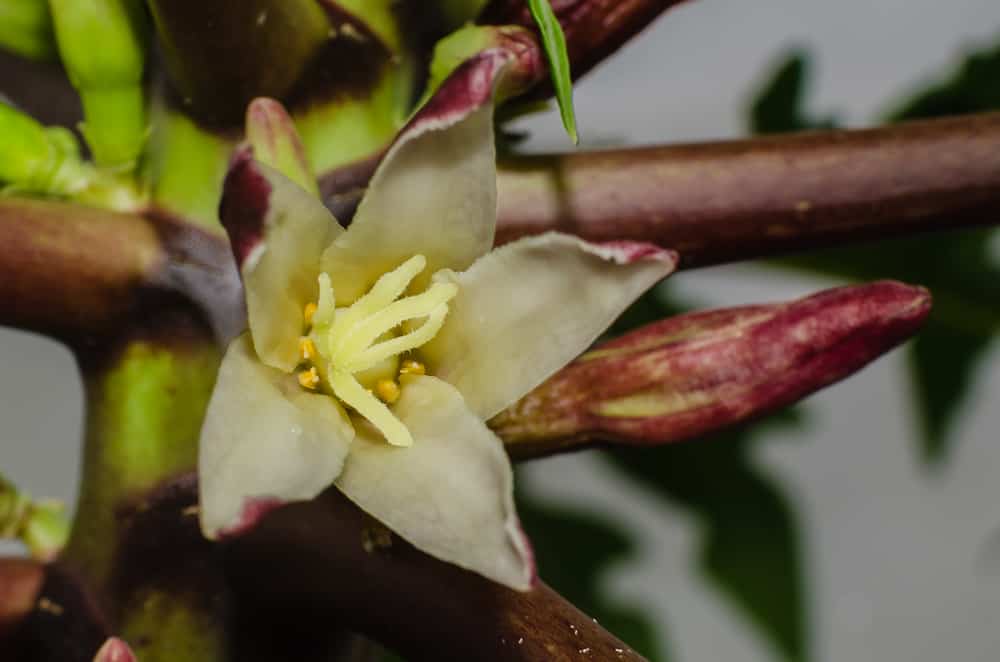
Growing Papayas in Texas Update: March 03, 2020
A slide into March and spring is firmly established in coastal Texas. The temperature forecast for the upcoming two weeks is free of frost or freeze. I decided to “let the kids out” of my makeshift greenhouse today. All are healthy and putting on flowers and fruits. A small amount of leaf damage from abrasion hasn’t seemed to have affected the plants.
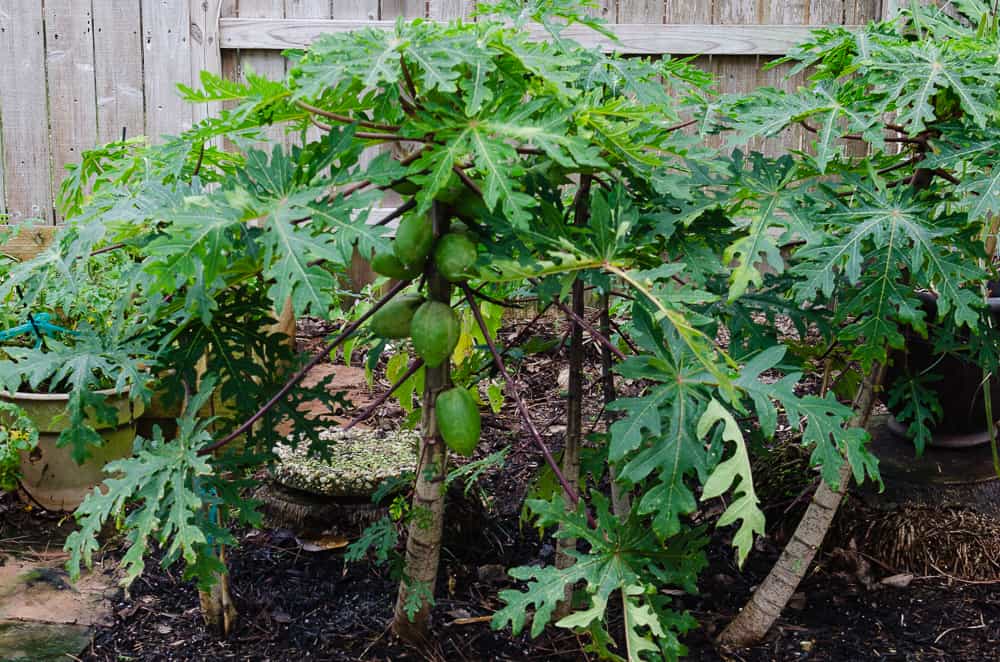
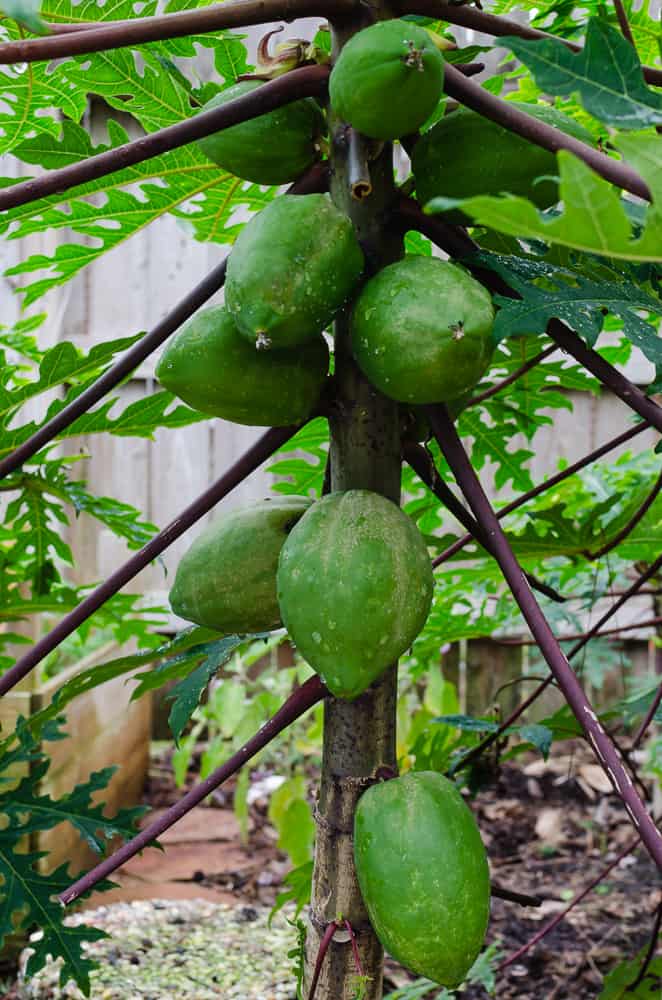
The hermaphrodite flowers have now set a few fruits. They are much more cylindrical than the females and also smaller at the same stage of development.
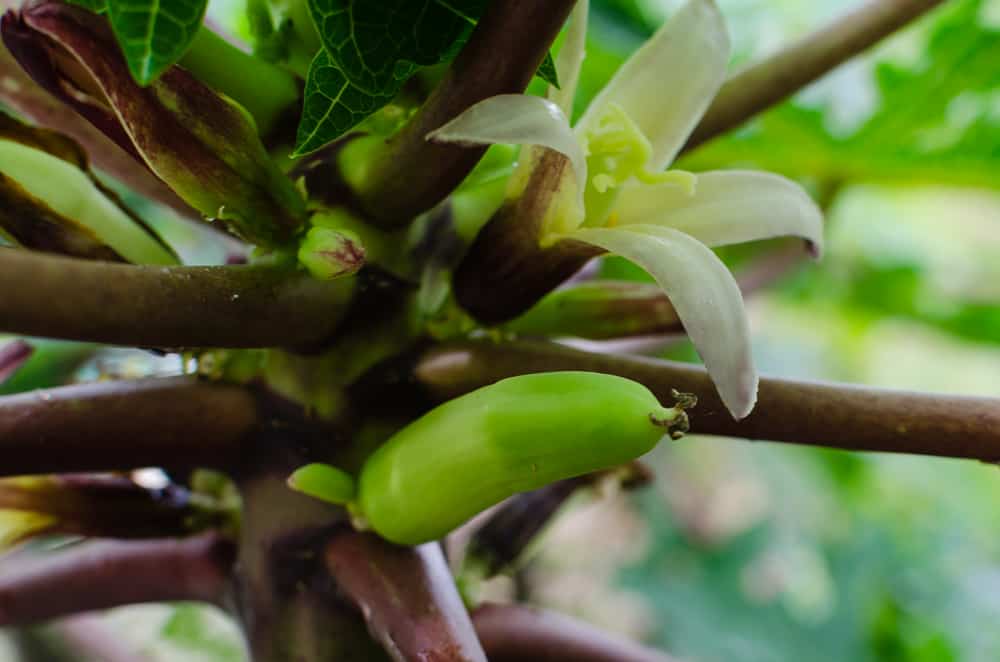
It appears that all of my plants are bearing hermaphrodite flowers with the exception of a single or possibly two females.
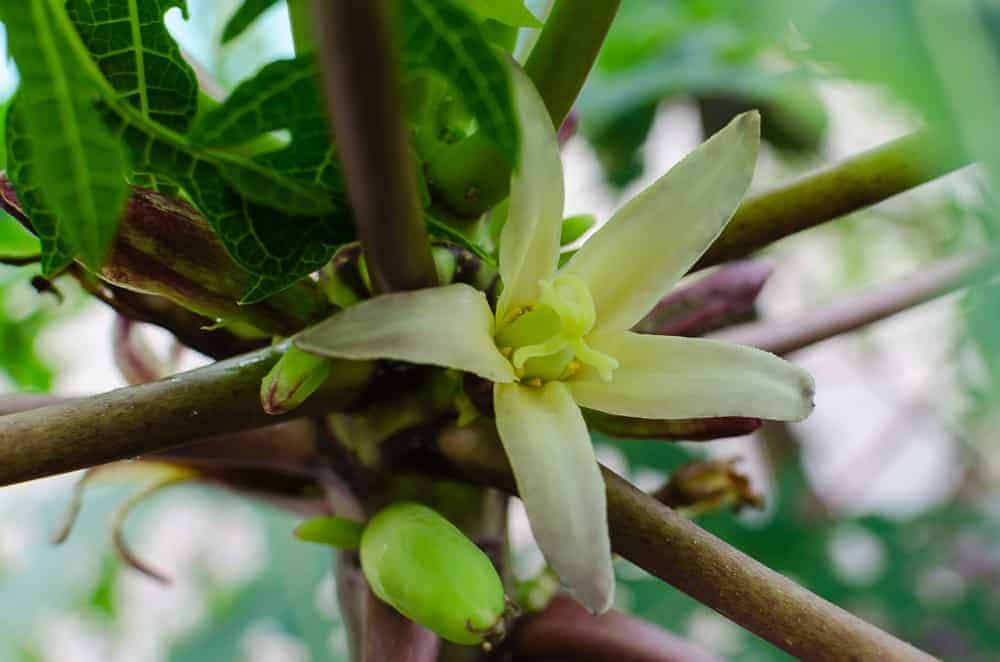
The plant with the female flowers is the biggest and was the first to flower and fruit. The fruits are getting bigger and putting on weight.
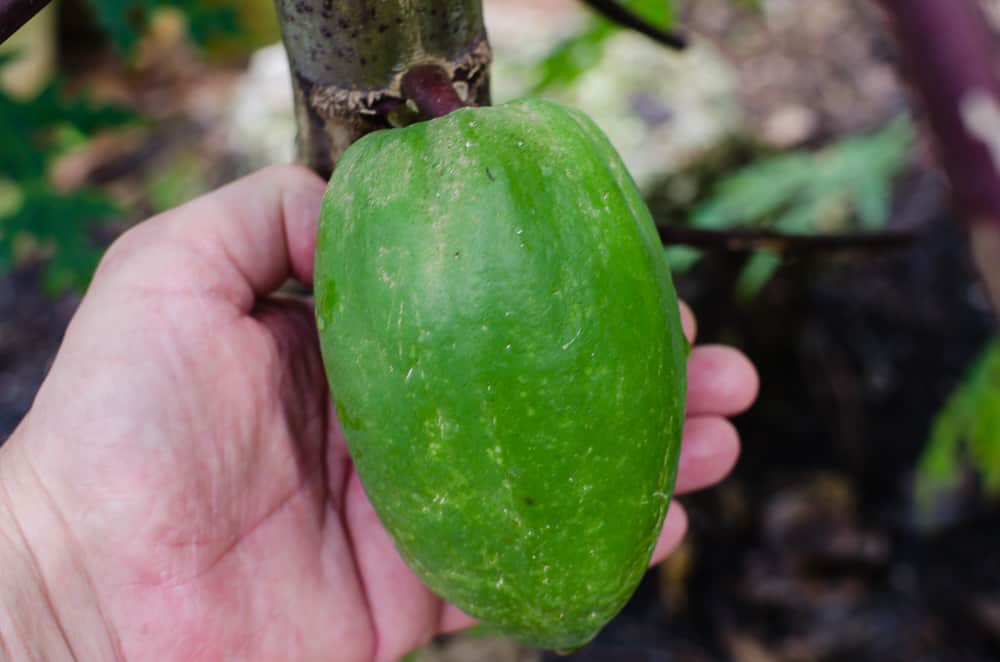
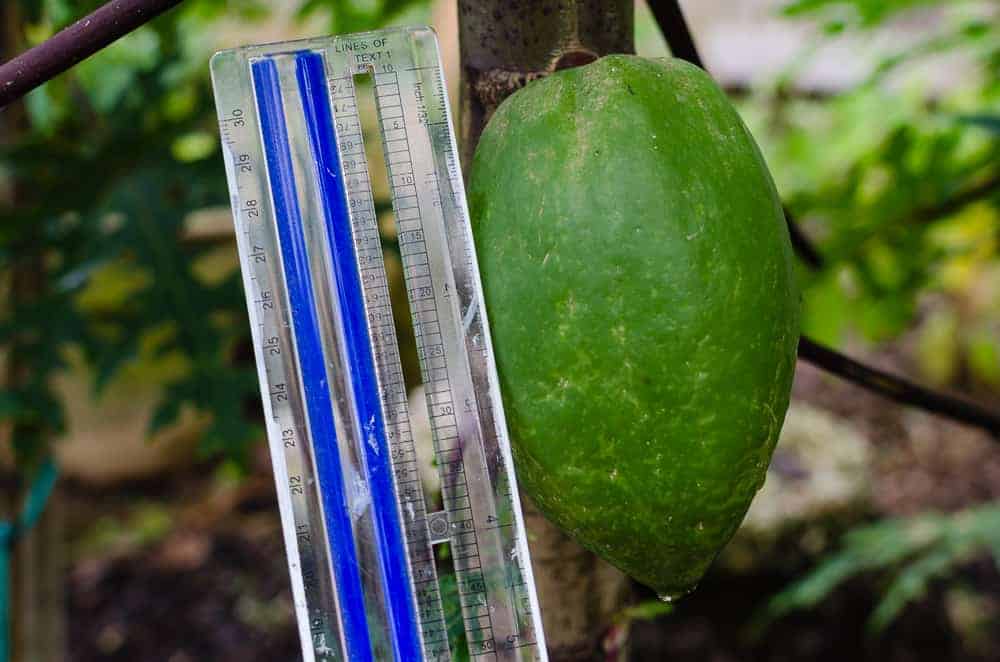
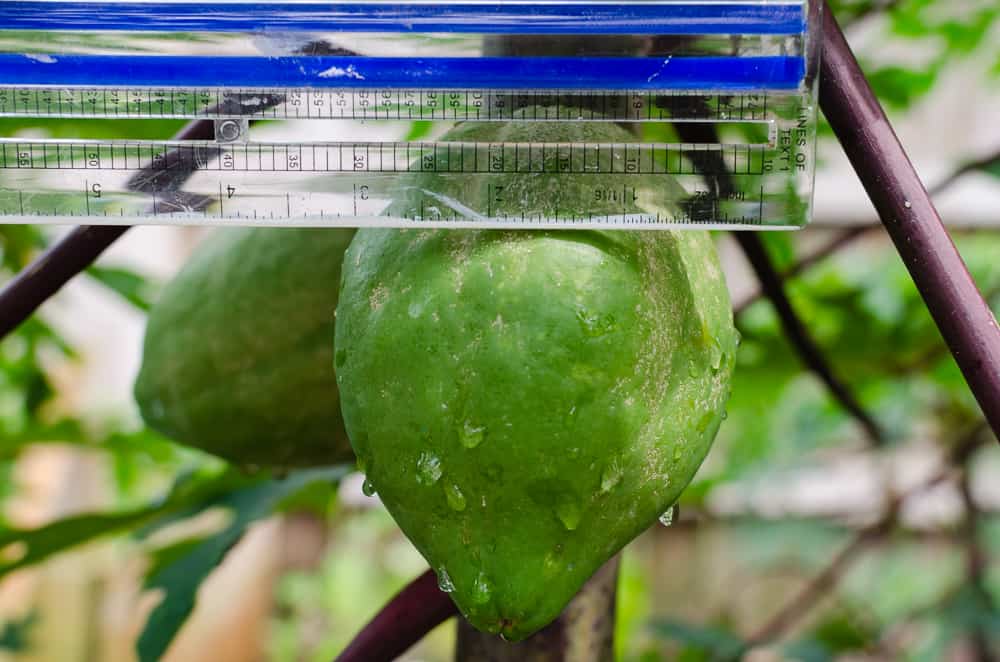
Growing Papayas in Texas Update: April 21st, 2020
We are rapidly approaching Texas summer. Abundant sunshine has allowed additional fruits on multiple trees. The female flowers continue to produce fruits and the hermaphrodites are starting to catch up.

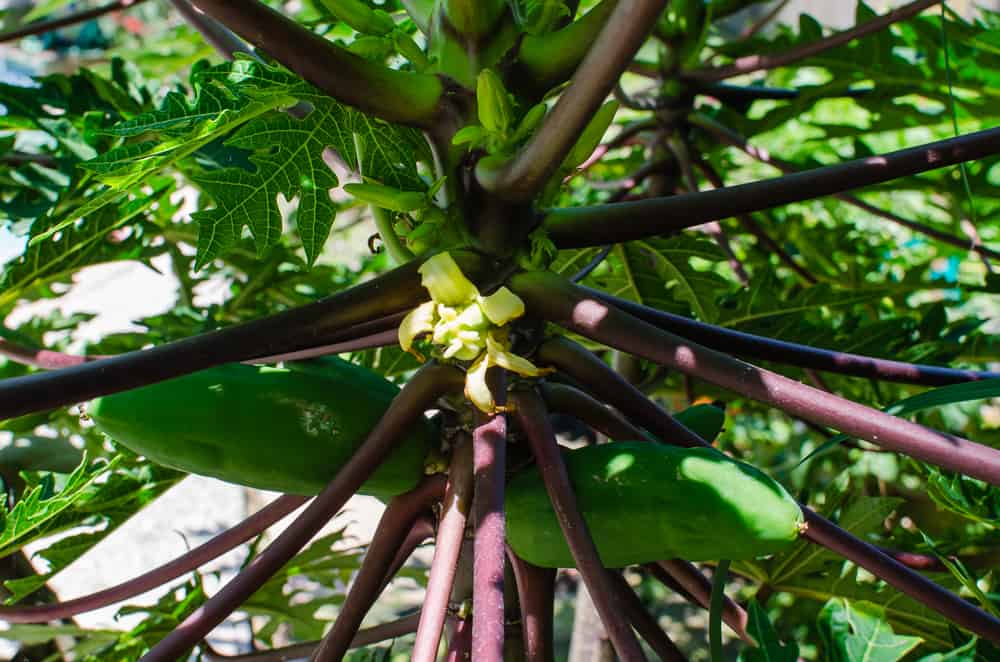
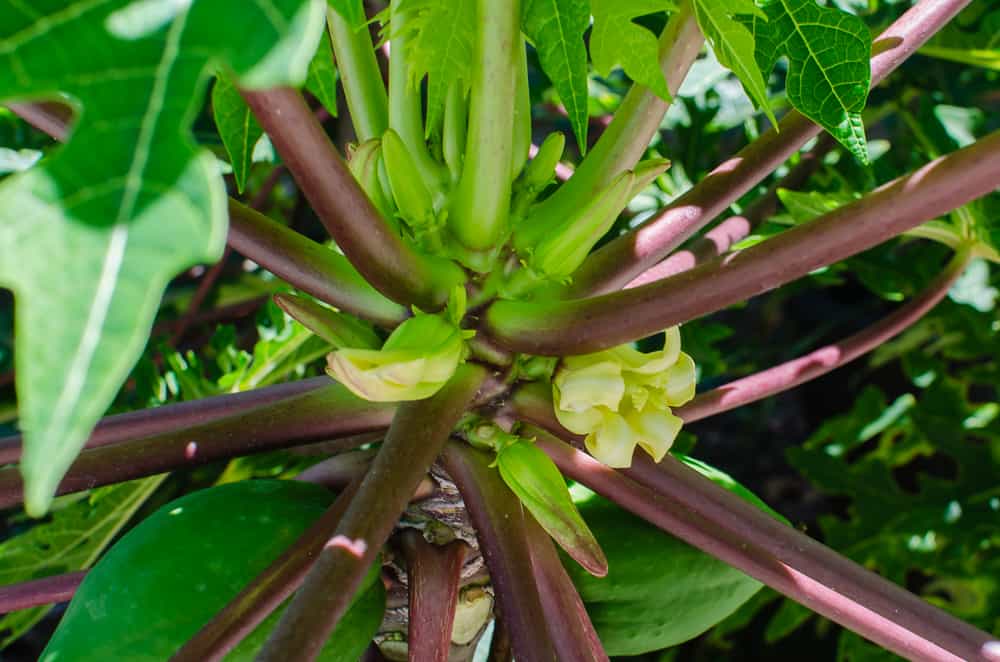
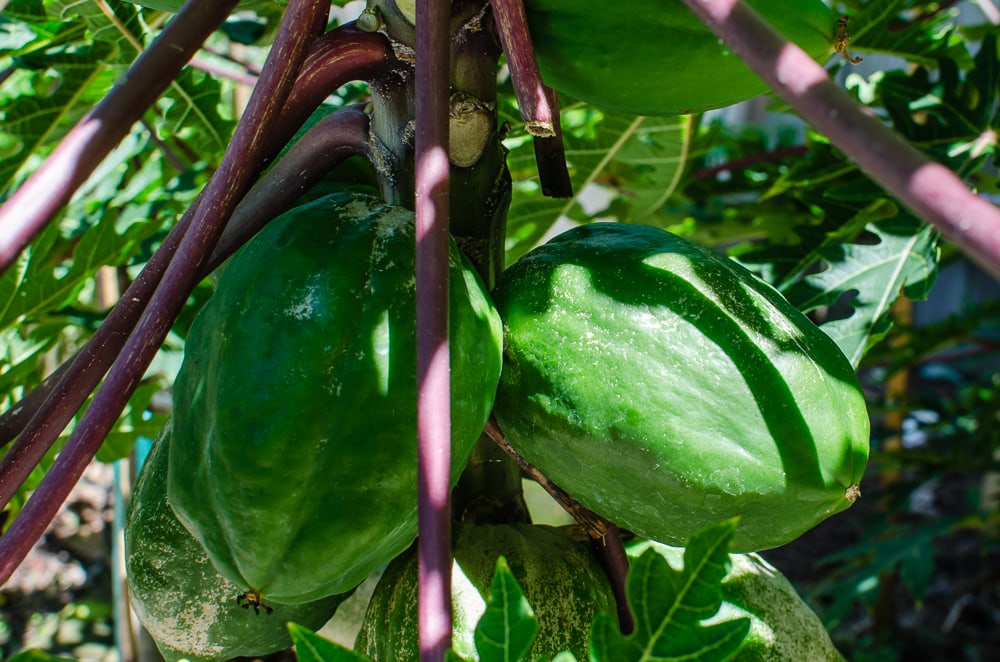
Carpelloidy in Papayas April 24, 2020
I noticed one of the fruits is malformed. Malformed fruit (carpelloidy) is a condition caused by the fusion of stamens to carpels in hermaphrodite flowers. It usually occurs with changes in environmental conditions. Changing temperatures or changes in soil moisture can shift hermaphrodite flowers toward femaleness. The resulting fruits become severely ridged. I’ll see how this one develops, but expect it will be misshapen.
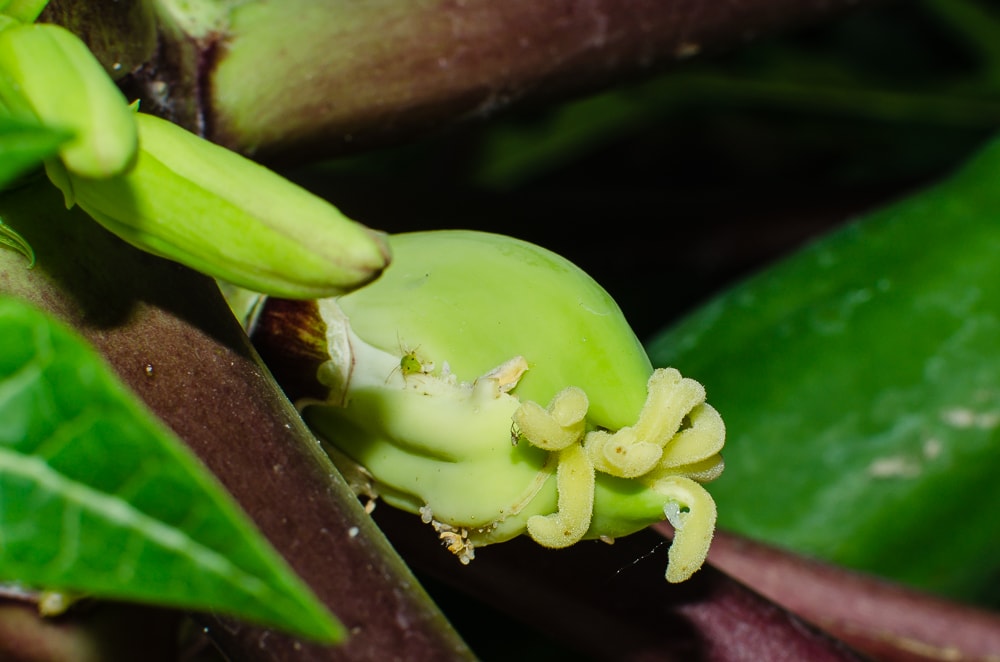
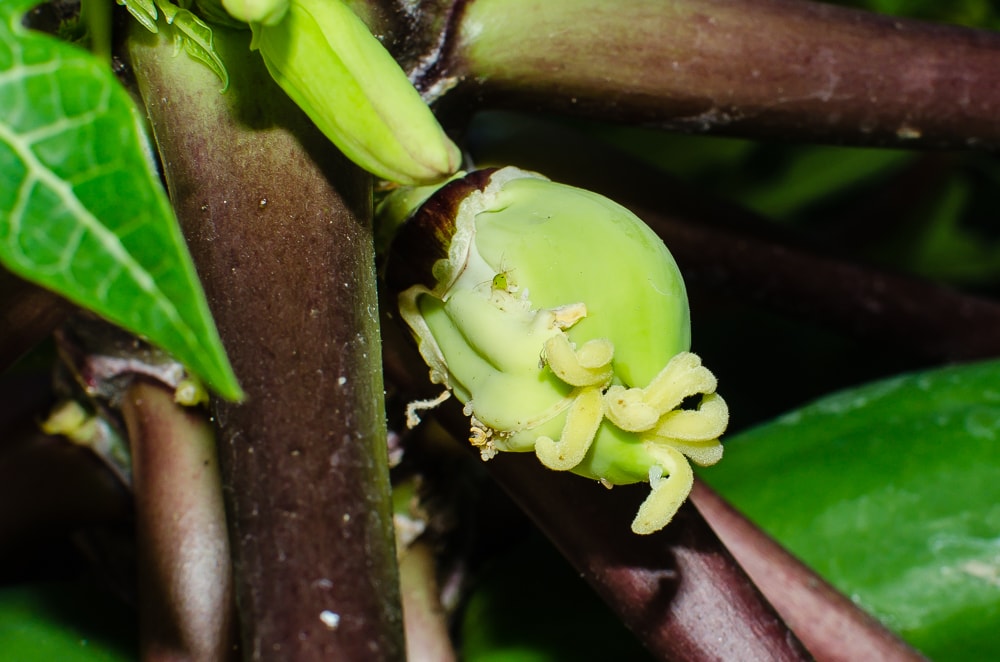
Growing Papayas in Texas Update: April 28th, 2020
One of the early set fruits from a female flower is starting to ripen. Its not very large but we’ll see what happens next!
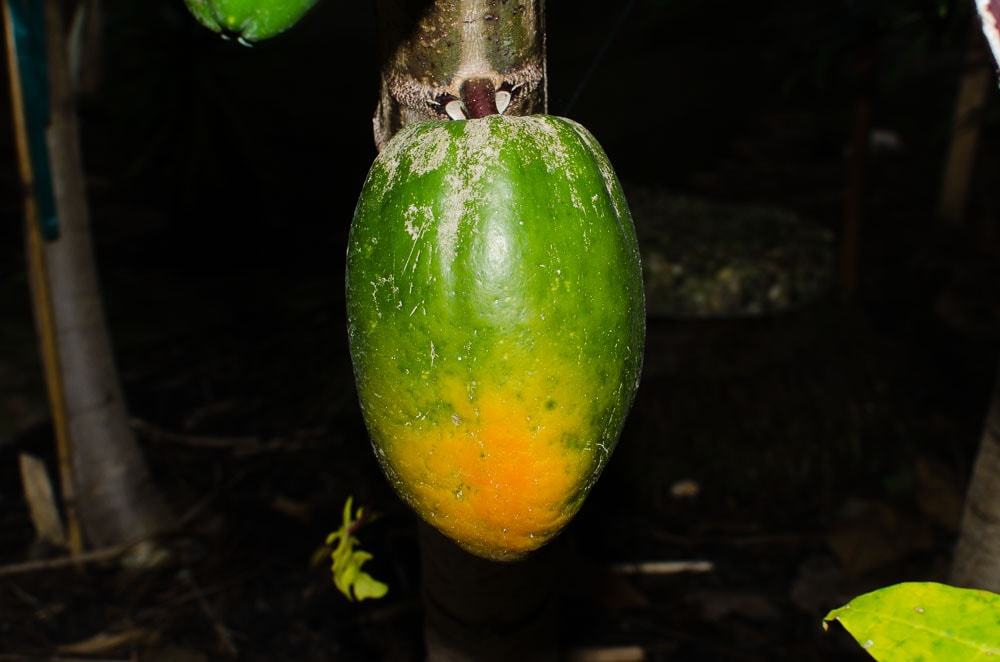
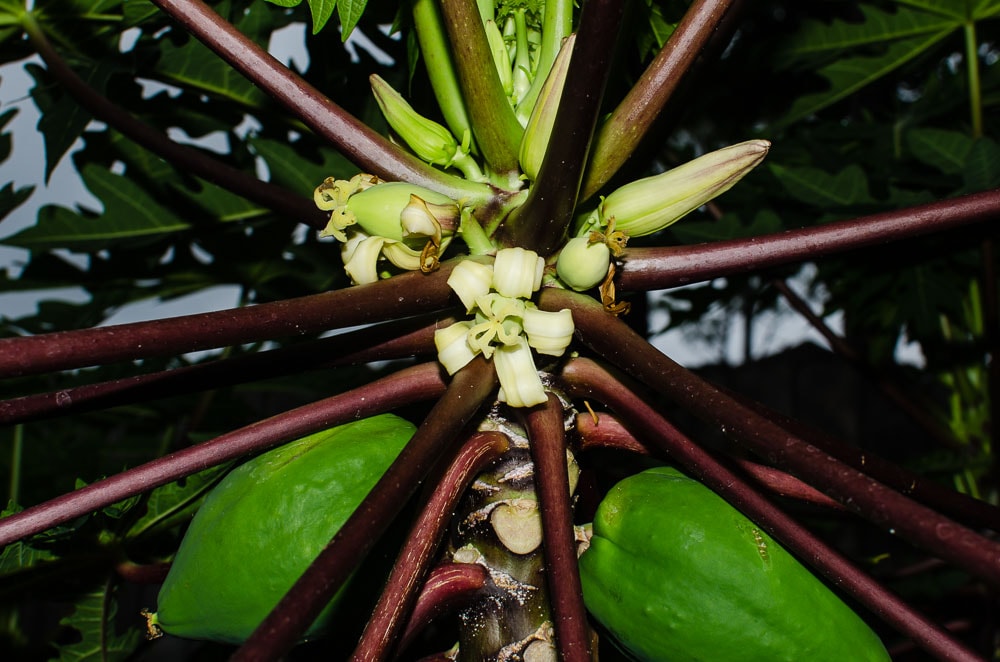
Growing Papayas in Texas Update: May 2nd, 2020
The small papaya is ripening quickly. I should know very shortly if it is edible.
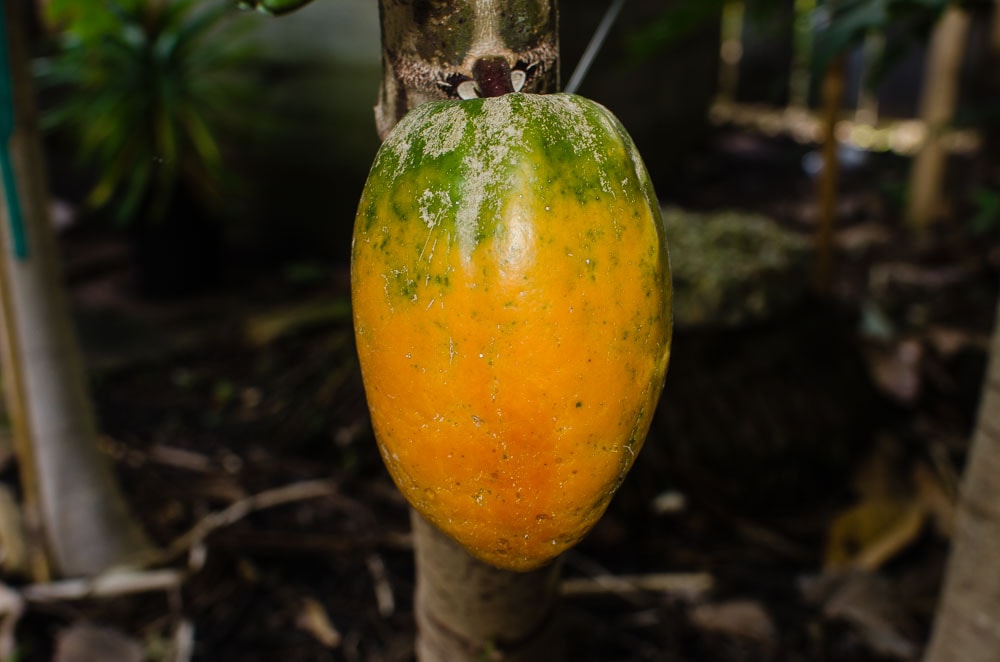
On a side note, I’m getting lots of male pumpkin flowers. No female flowers or pollination yet.
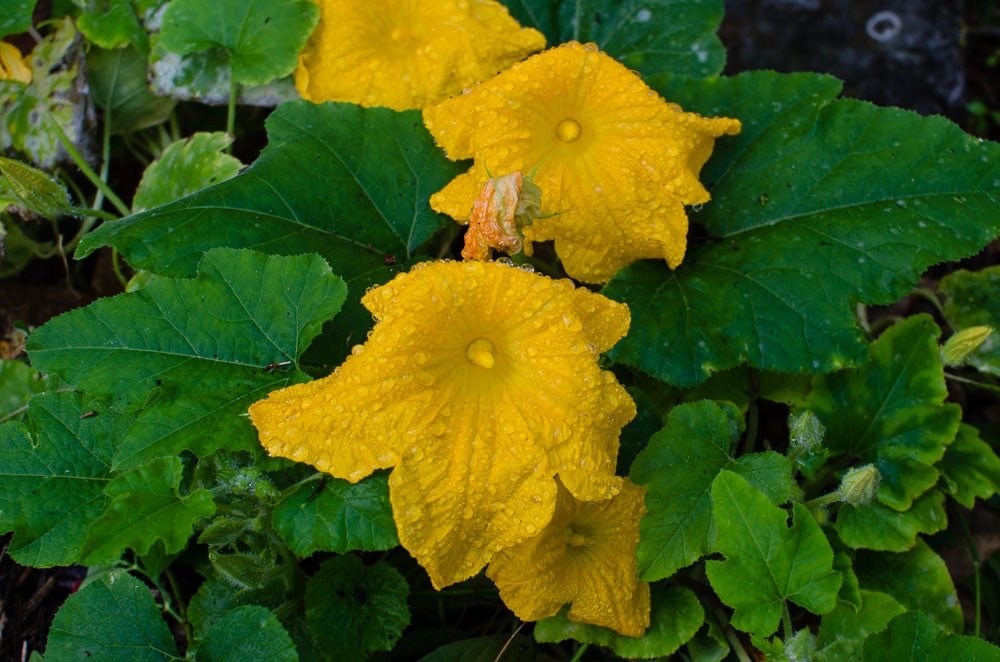
Growing Papayas in Texas Update: May 7th, 2020
I picked a small papaya a few days back. It was about 70% yellow and there seemed to be some damage near the tip so I pulled it from the tree. It was one of the first fruits to appear on my female tree. The fruit survived the winter, however it didn’t seem to want to get any bigger. The female had no pollinators nearby when the flower first appeared. As a result this fruit is seedless. As you can see it is quite small but surprisingly tasty. Hopefully the newer fruits will get larger now that the warm weather and sun have returned. Lots of sun and 90 degree days are here now.
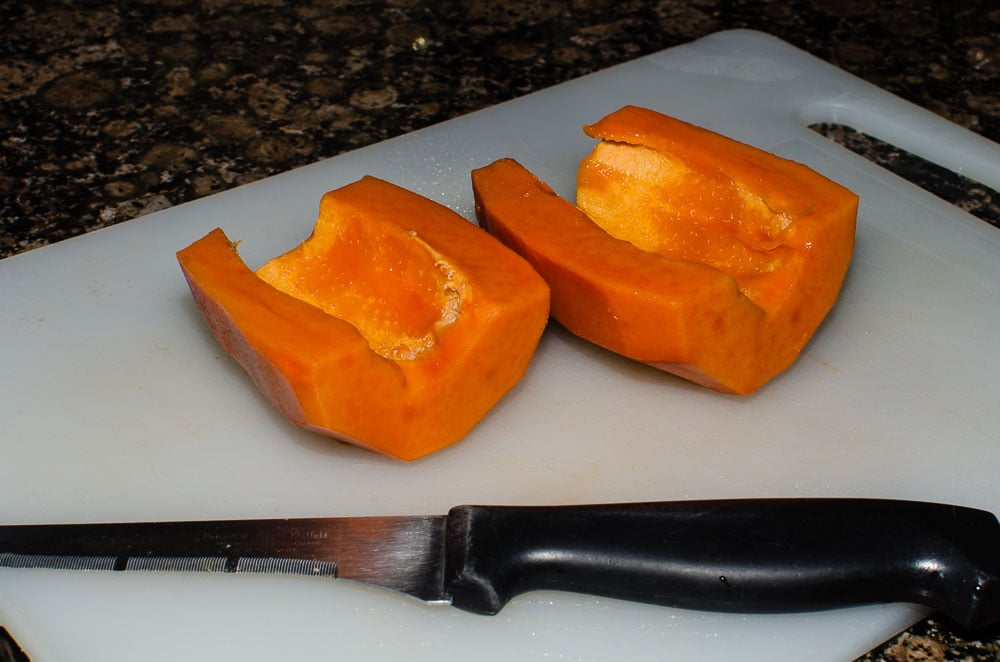
Growing Papayas in Texas Update: May 17th, 2020
Warm weather, abundant sunshine and adequate rain persits. All of the trees are putting out lots of flowers and setting fruits. My tallest tree is now about 6 1/2 feet tall and is producing elongated fruits from perfect flowers. The female flowers, in contrast are producing more rounded fruits. With the onset of better weather, the fruits appear to be increasing in size much more than the fruits that set during the winter.
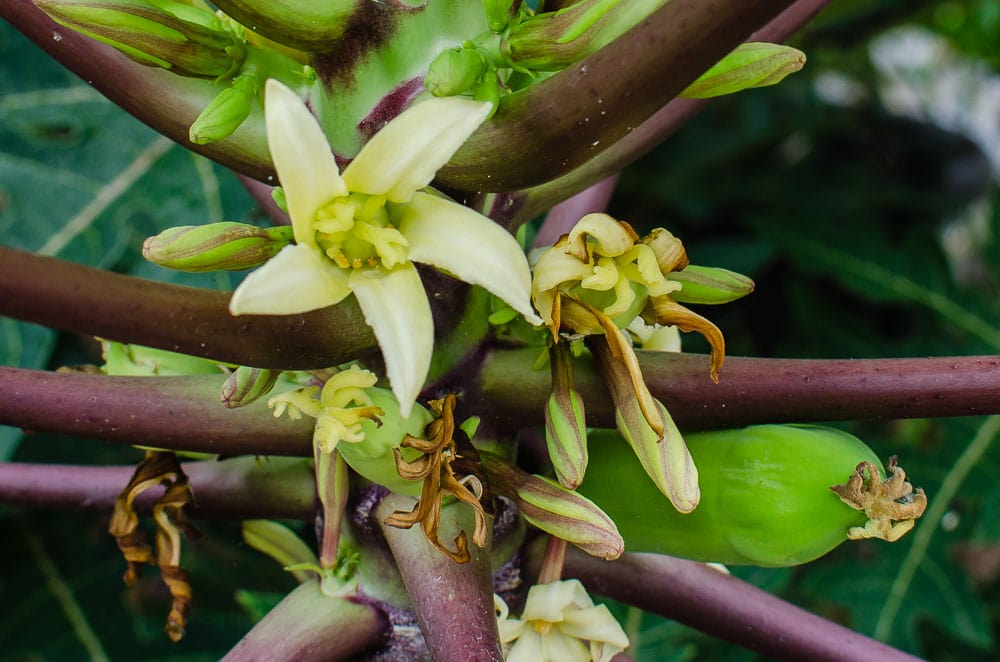
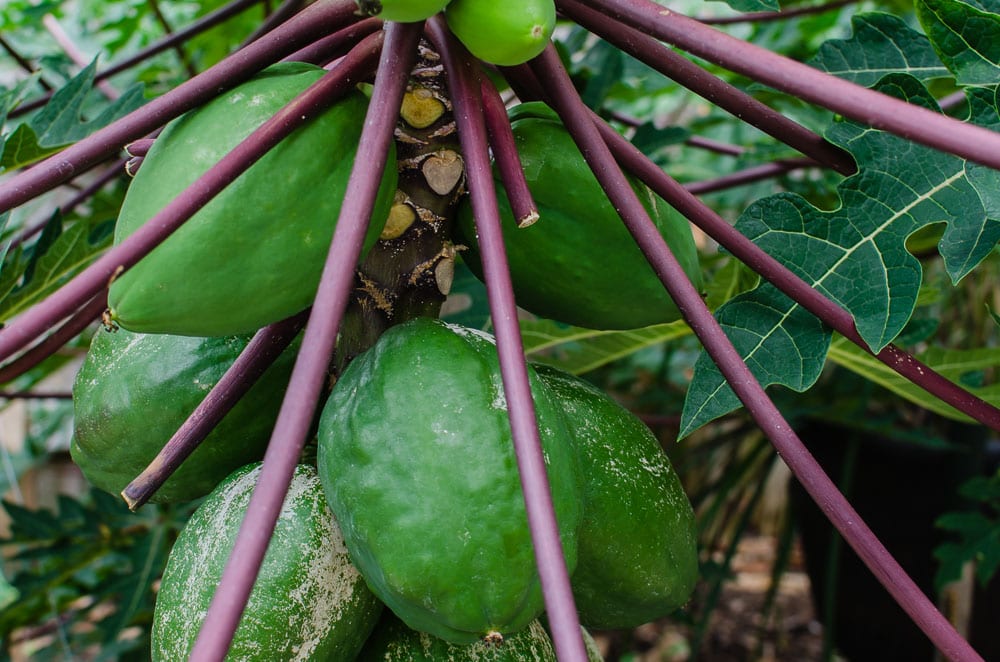
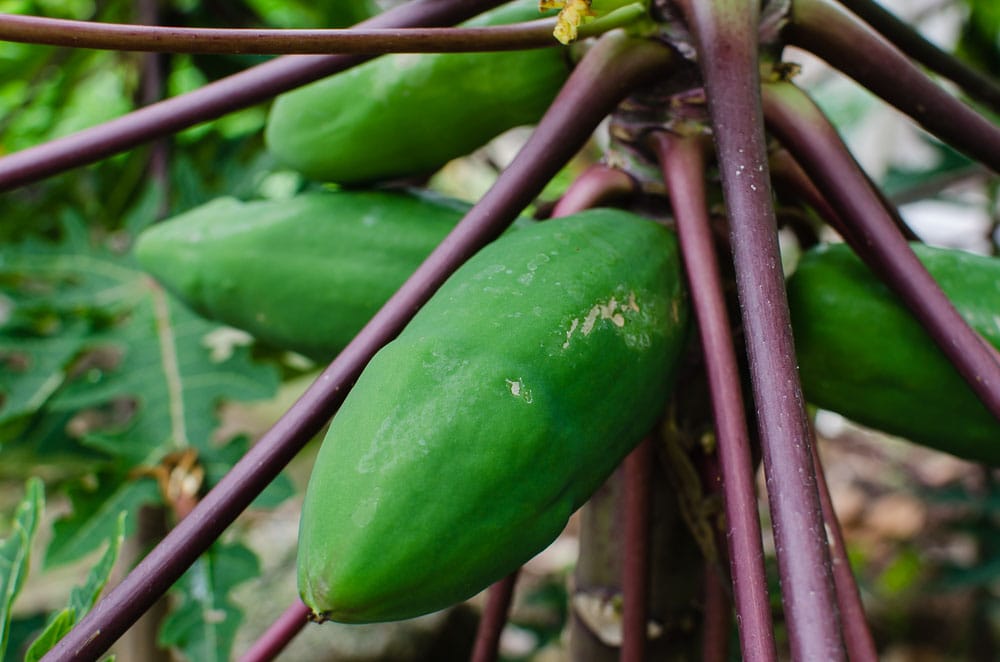
On a side note, the Variegated Ginger is flowering.
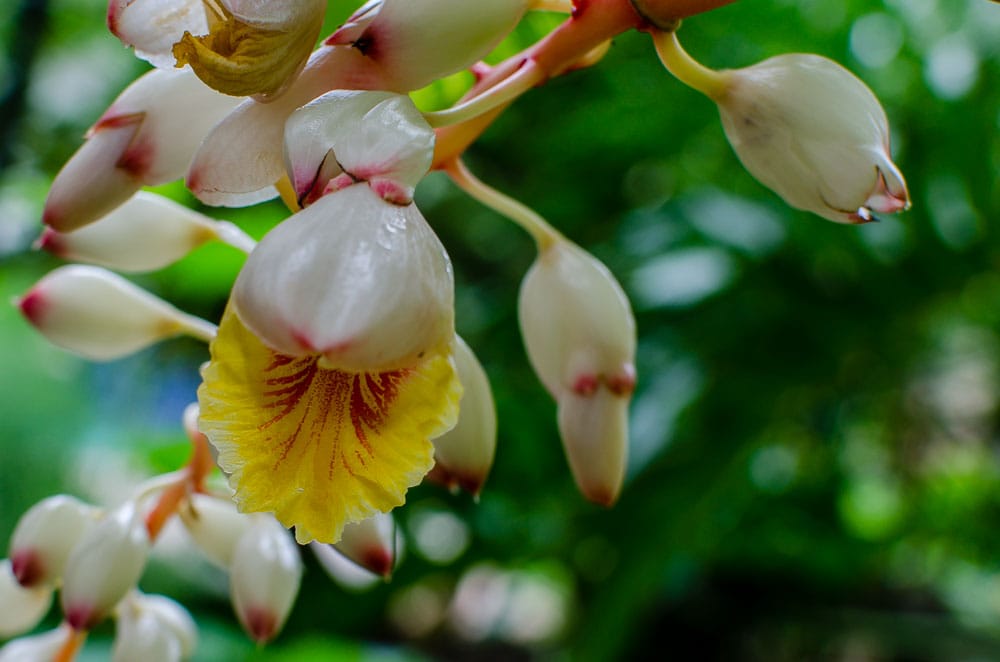
Growing Papayas in Texas Update: June 2nd, 2020
Apparently I’m not the only one fond of papaya. I was about to harvest a small ripening fruit soon. This morning I found this. I suspect it was an opossum or a racoon. I’m not pleased!
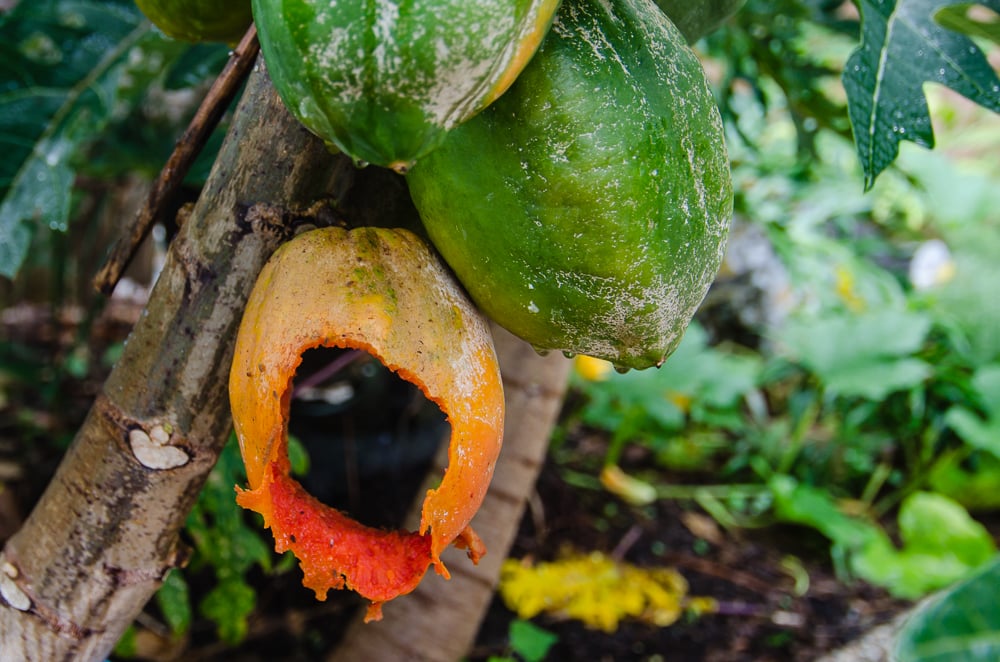
Growing Papayas in Texas Update: June 8th, 2020
Today I managed to harvest another small papaya. Small, seedless and sweet. I can see a future problem with critters trying to beat me to the fruit. Although this fruit did not exhibit a completely yellow skin, it was ripe. I will continue to havest a bit early and let them ripen further off the trees. I believe that will be the only way to stave off nighttime marauders.
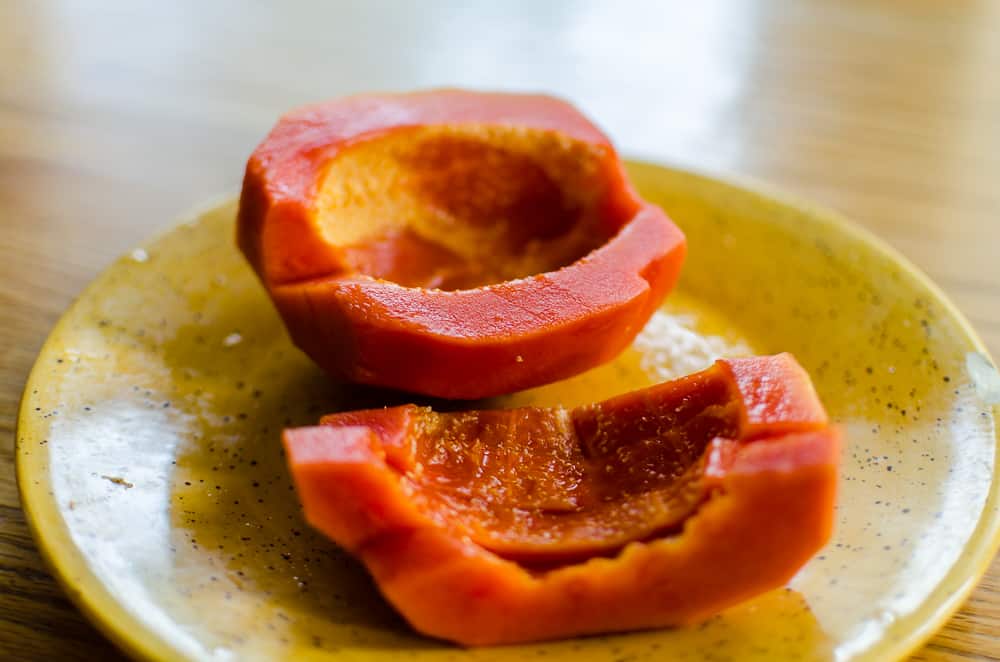
One of my trees is now about 7 feet tall. It is producing male and hermaphrodite flowers along with large fruits. Some of the fruits are about 10 inches long and still putting on weight.
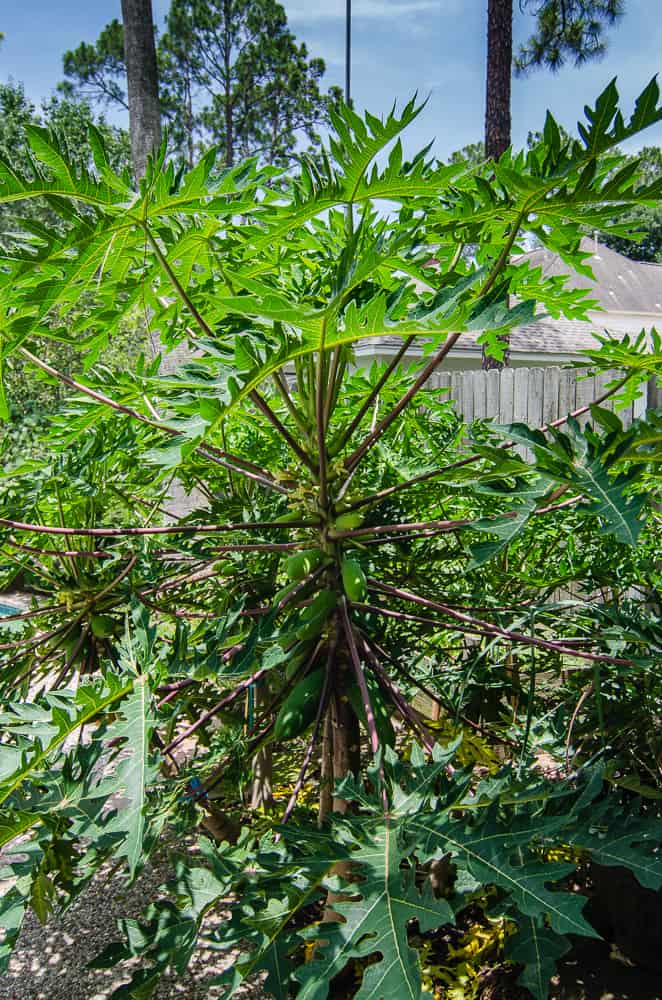
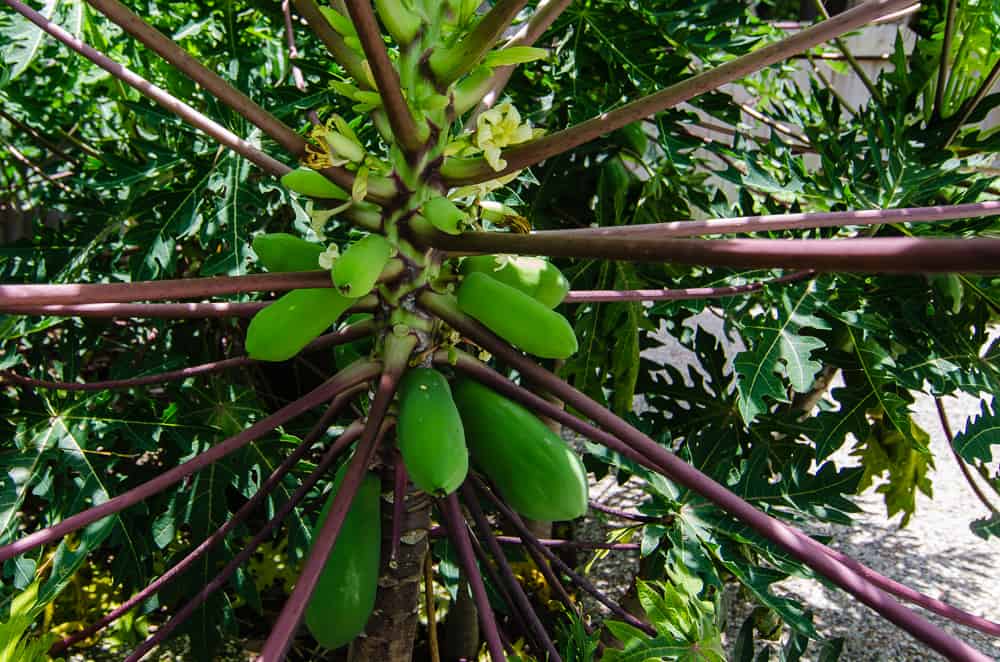
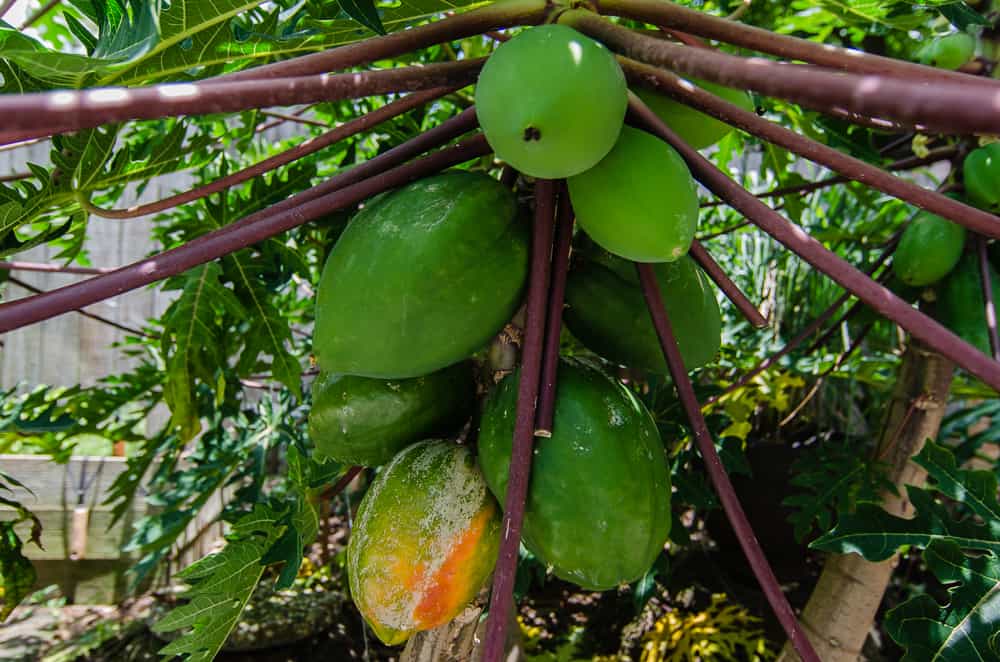
Growing Papayas in Texas Update: June 23th, 2020
Abundant sunshine makes for abundant fruit. So far I have harvested four small fruits. All were tasty but I have seen some anthracnose on them. I’m currently treating with a preventative fungicide. Hopefully this will eliminate the problem. Anthracnose is common with papaya in very humid conditions.
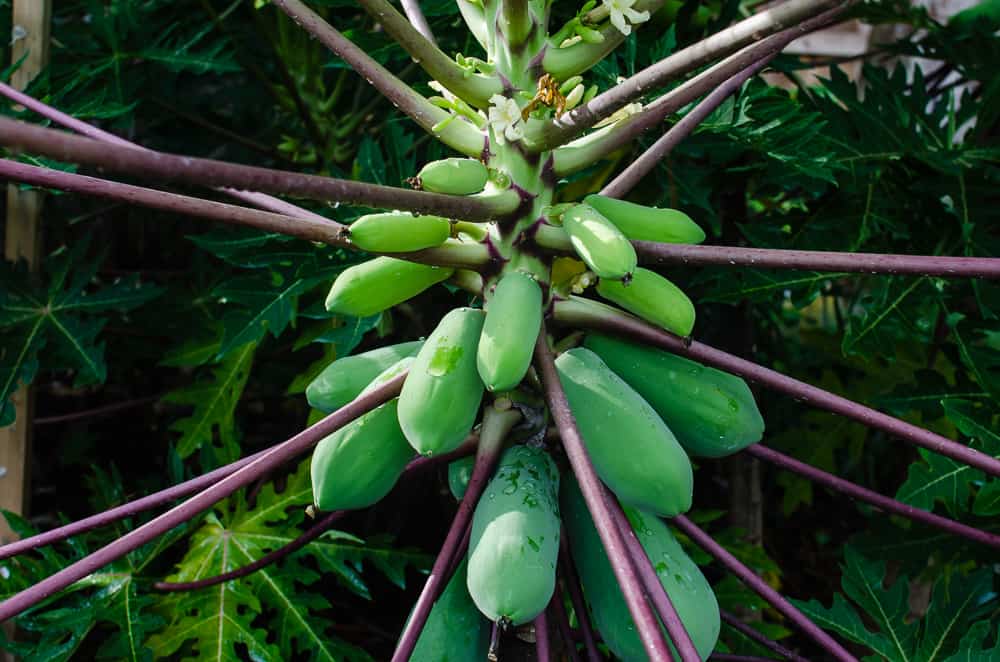
Growing Papayas in Texas Update: July 13th, 2020
Today I decided that I had too many papaya plants, too close together. Some of them were being crowded out and competing for sunlight, water and soil nutrients. I thinned out the “orchard” by removing two of the plants. Both plants were bearing some fruit. One was a female and the other was a hermaphrodite. There were seven developing fruits from the two plants. I dissected the fruits to determine the status of pollination on each.
I observed four different morphologies.
- Female
- Carpelloid Female
- Sterile hermaphrodite. (this was one of the first hermaphrodite fruits observed and has a “cucumber” shape)
- Hermaphrodite
This image shows the range diversity in papaya fruit development.
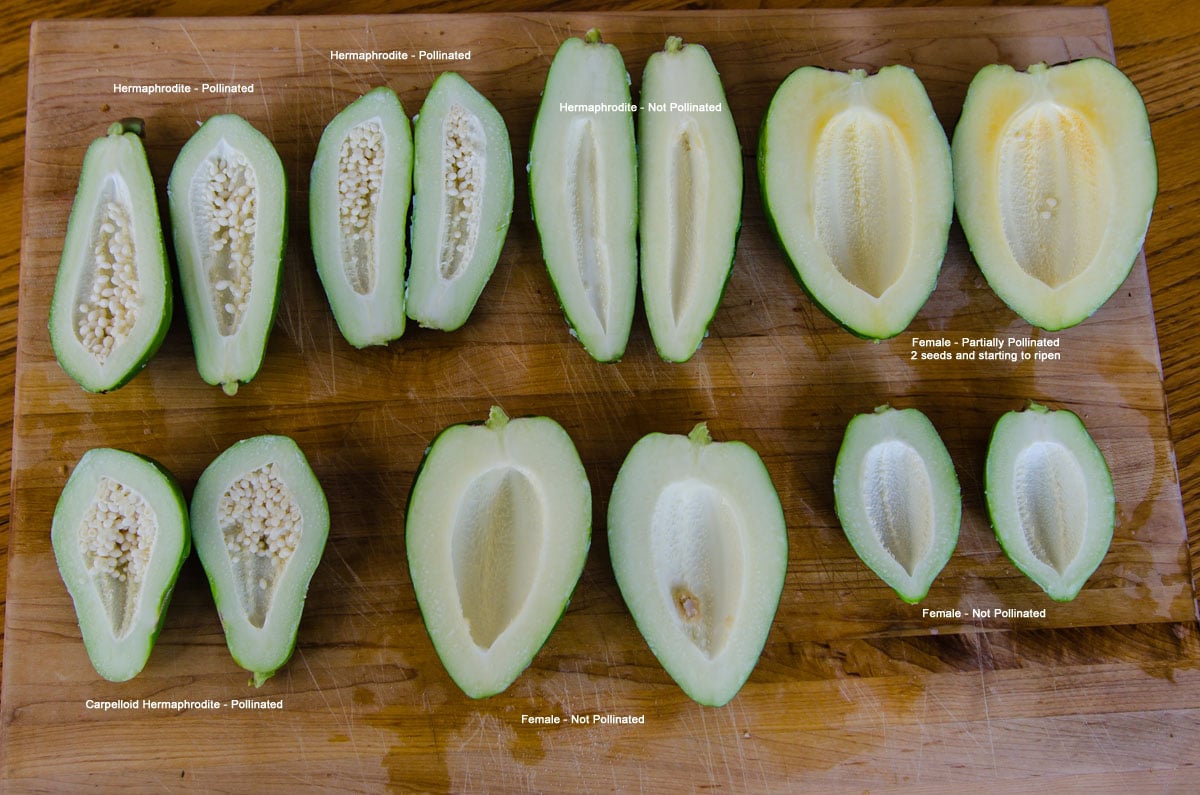
Never let a good papaya go to waste! I peeled and cut the raw green papaya into chunks and put together a quick dinner. The dish was a thai coconut curry made with Massaman Curry Paste. Cooked green papaya is reminiscent of a winter squash in texture, but a bit firmer. The taste is very neutral, but it goes well in the curry. A very tasty pairing with steamed Jasmine rice.

Growing Papayas in Texas Update: August 17th, 2020
Today I harvested a single papaya. It was a partially pollinated fruit from a hermaphrodite flower. The fruit was about 5 months developing to this stage. Fruits that developed later in the year are significantly larger. However it was nicely ripened and sweet. Good texture too.
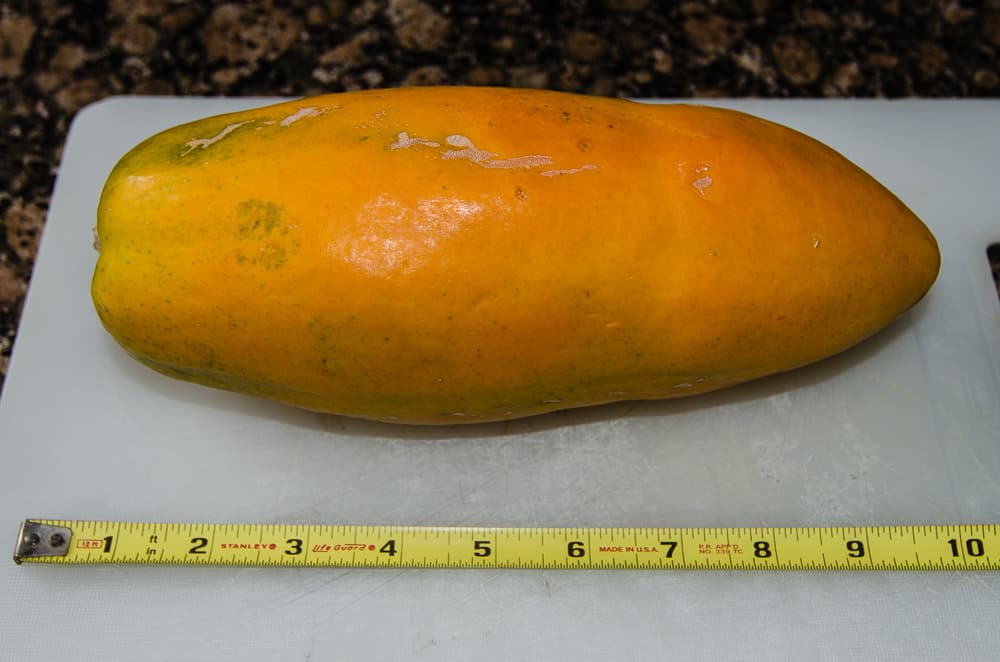
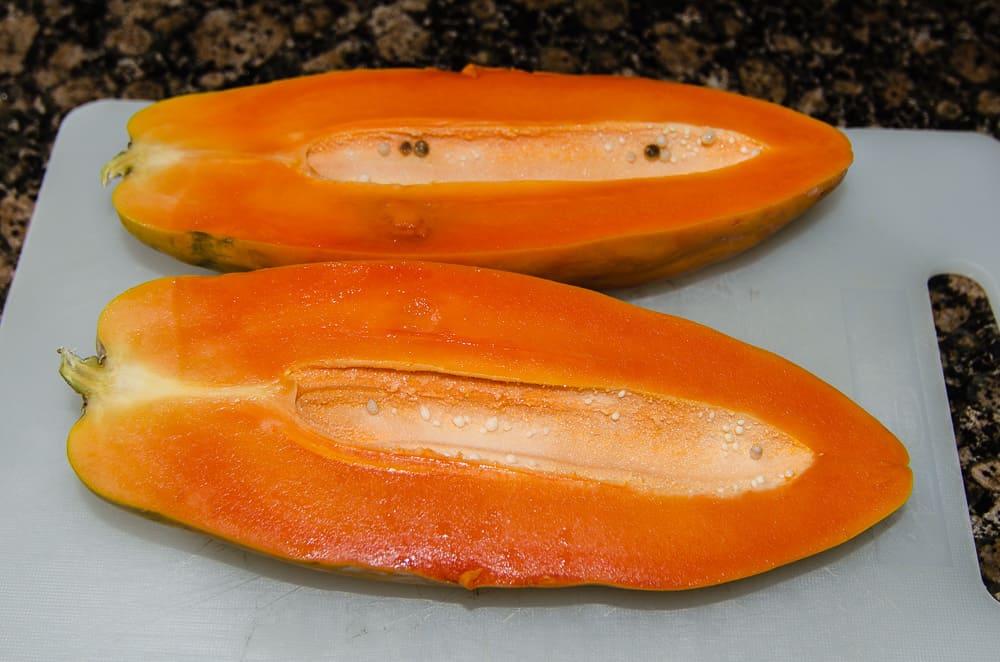
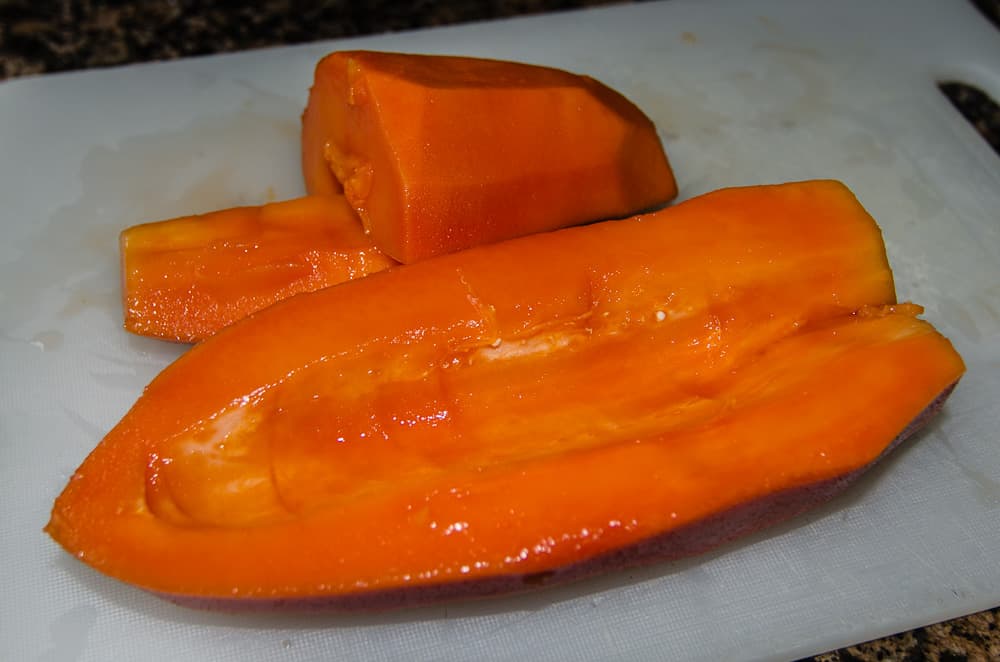
Many more to come.
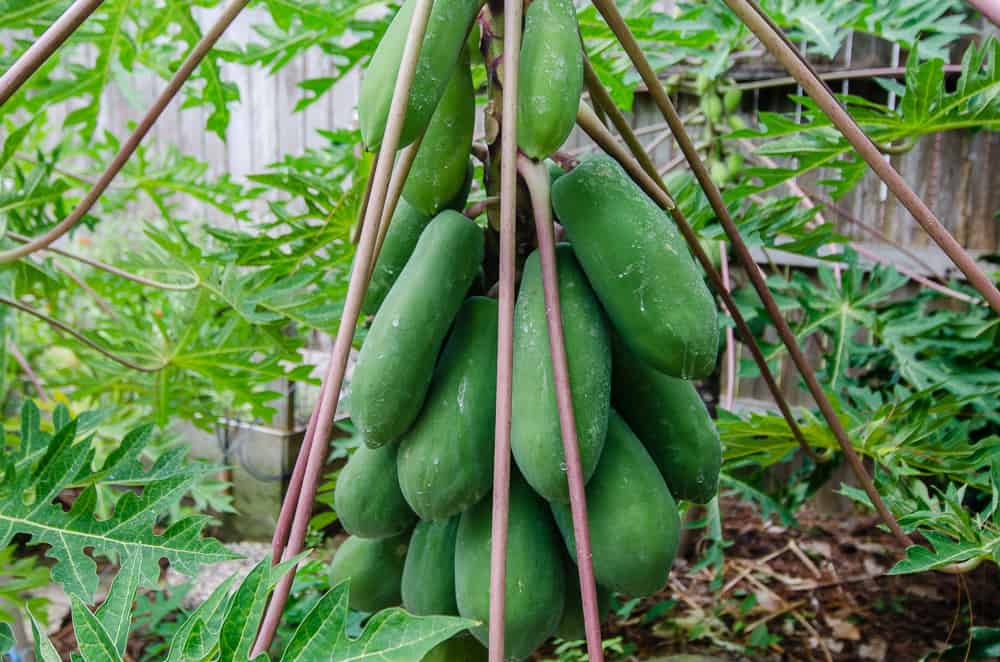
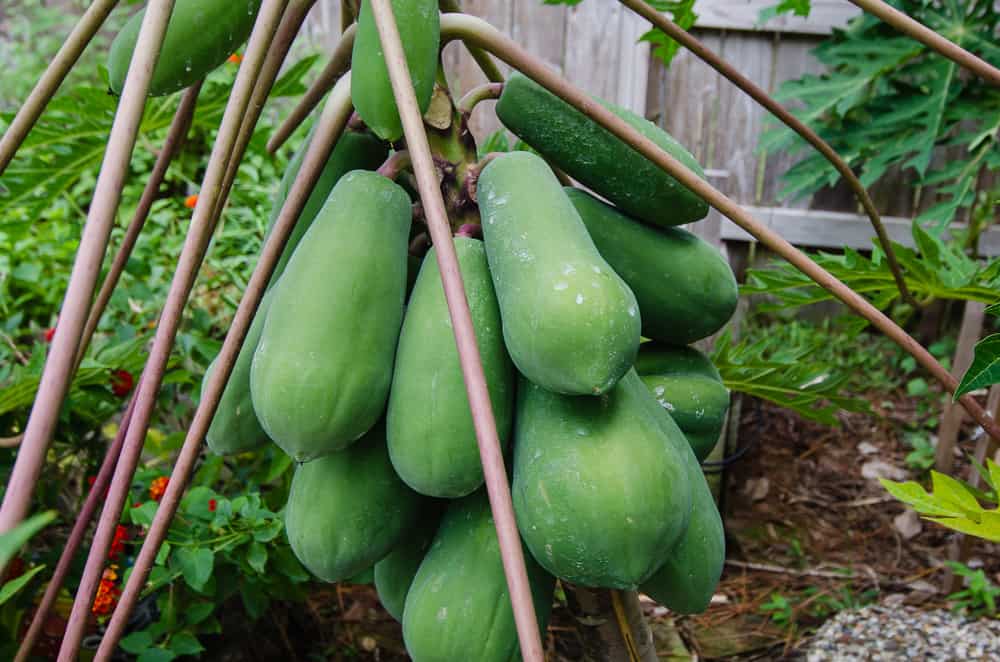
Growing Papayas in Texas Update: September 06th, 2020
A quick photo of today’s harvest. Very sweet and juicy. It was pollinated and had some seeds.
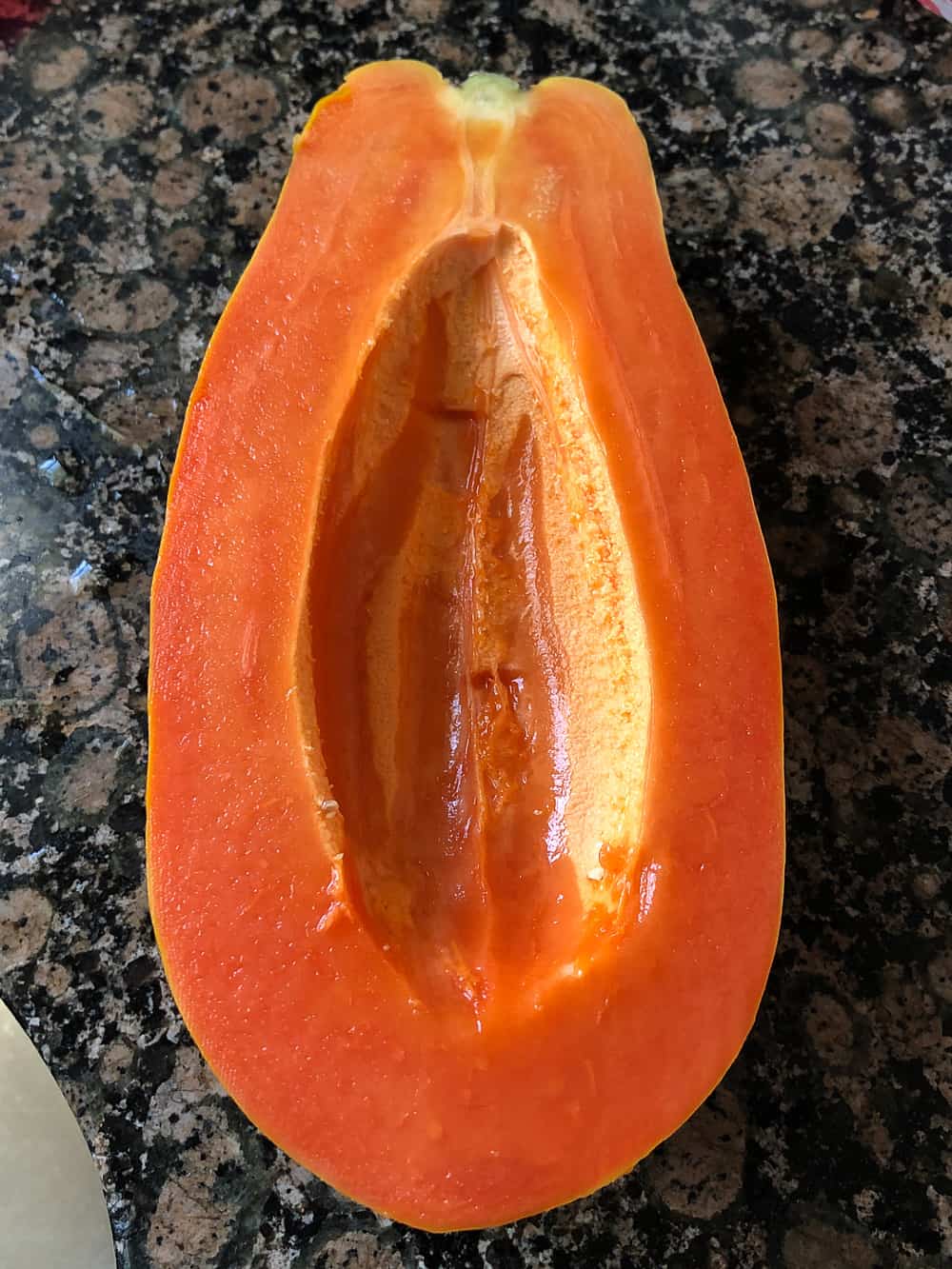
Growing Papayas in Texas Update: September 29th, 2020
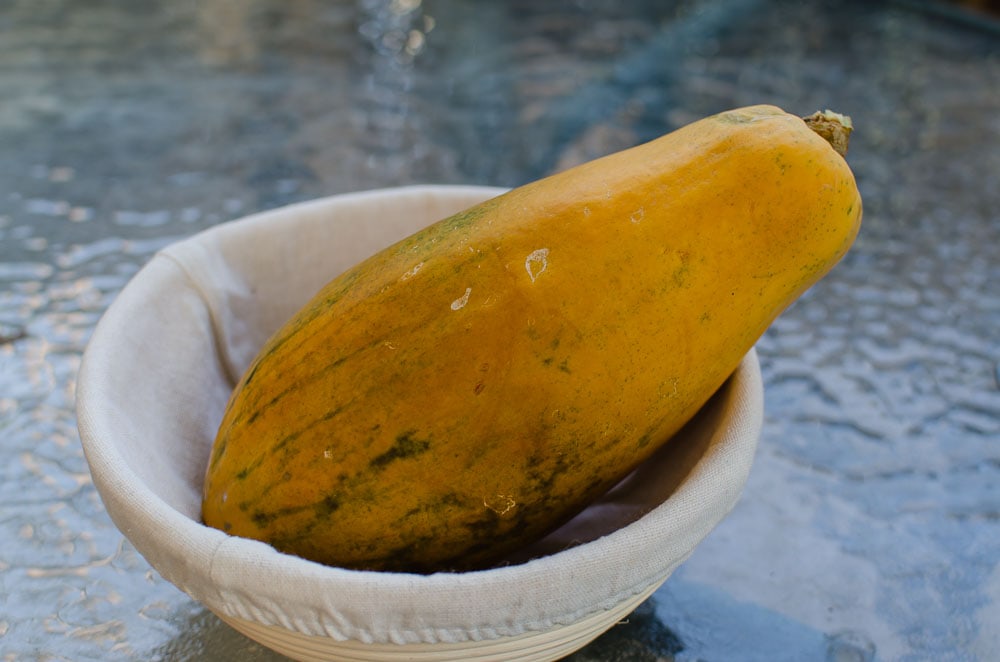
A cold front came through yesterday. Fall is here and I harvested a tree ripened papaya today. The fruit came from a hermaphrodite flower. The papaya weighs 1120 grams (about 2 1/2 lb) and is about 10 inches long.
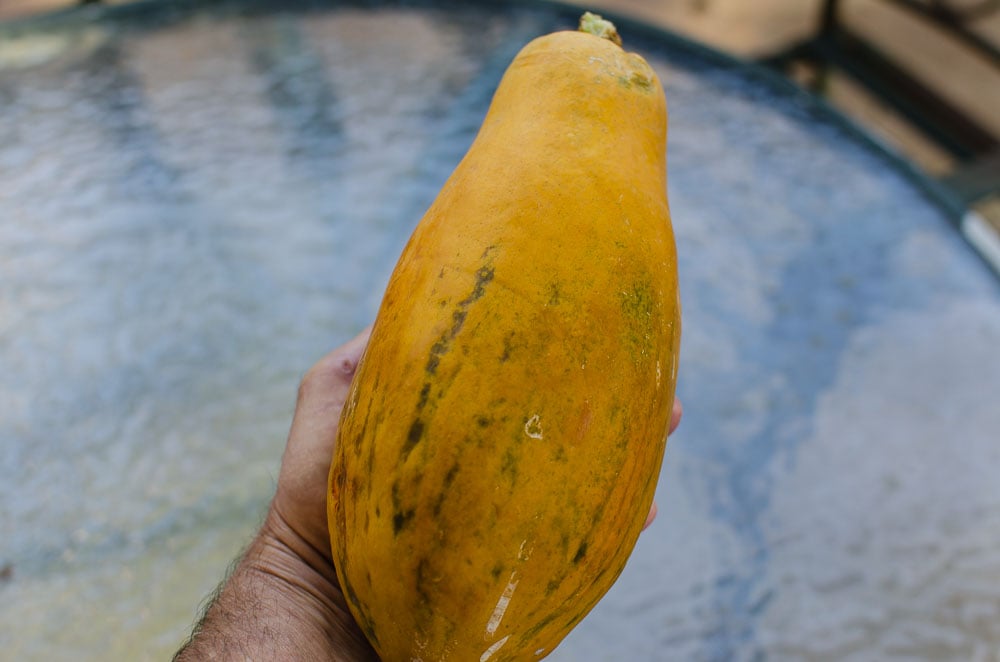
This fruit may be the best papaya I have tasted in a very long time.
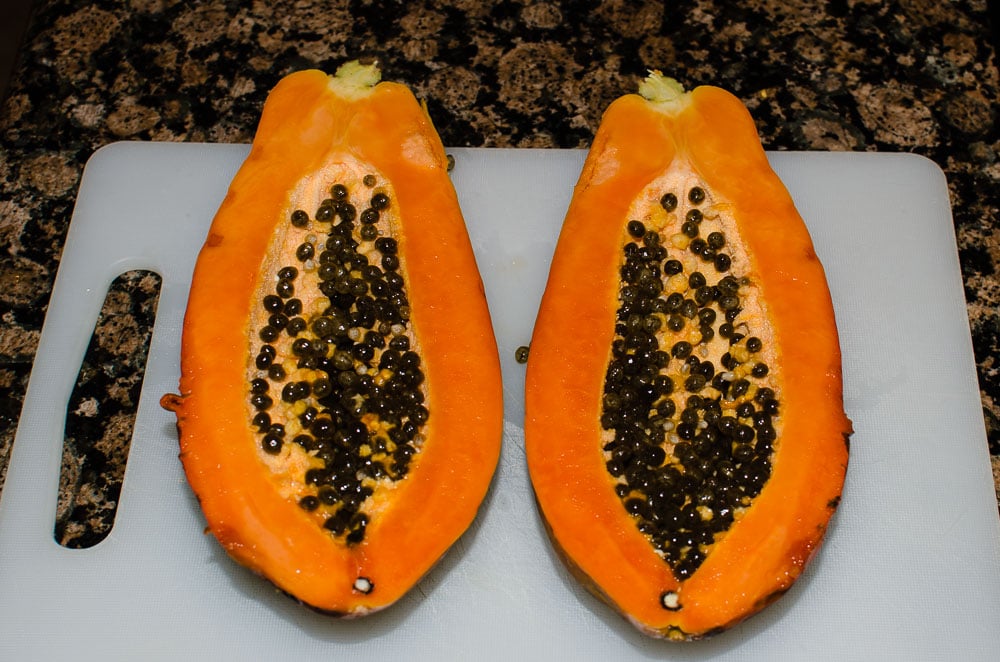
Growing Papayas in Texas Update: October 06th, 2020
I harvested a few papayas for final ripening in the past few days. The fruits are very sweet and soon I will be overloaded when the rest of the fruits start to ripen. I cut one that was ready and it was very sweet and delicious.
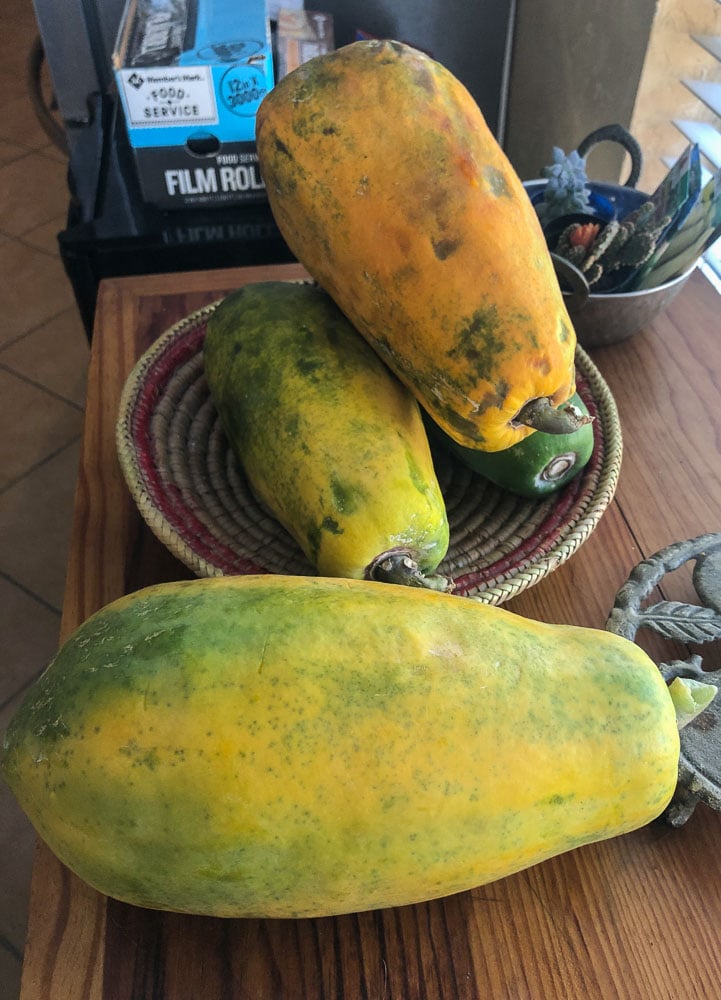
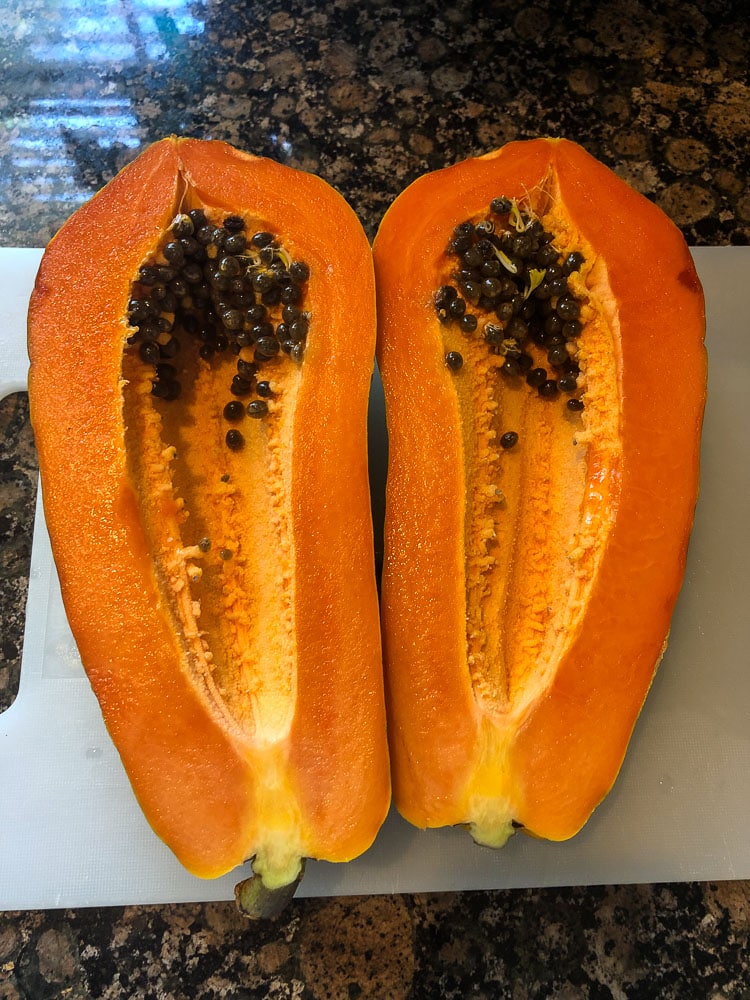
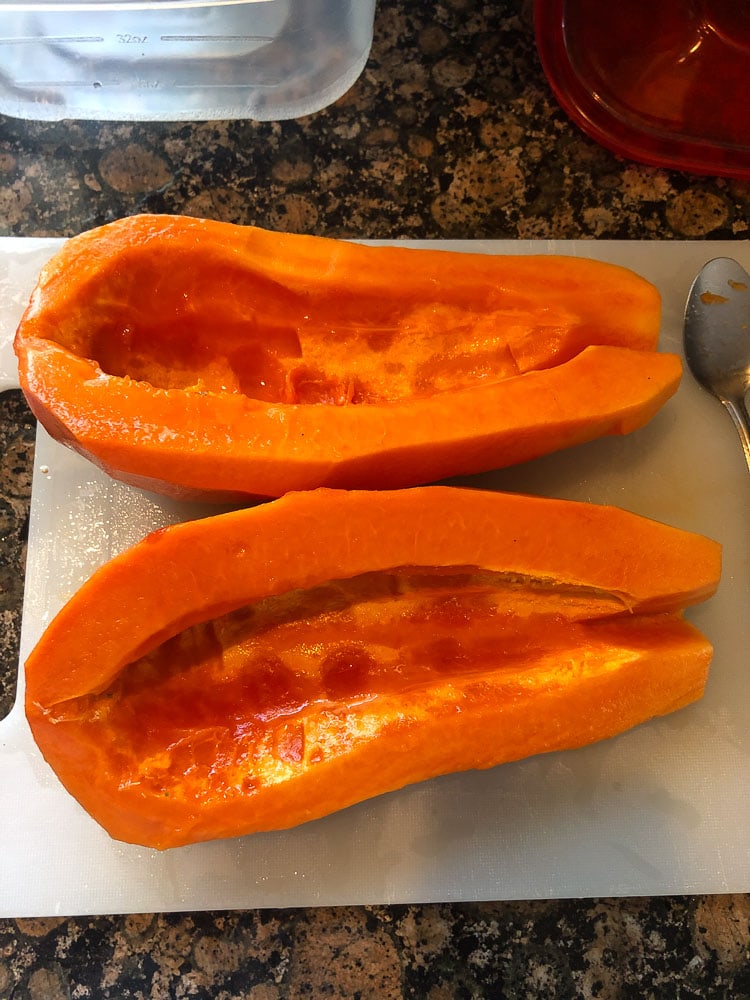
The largest papaya was almost 11 inches long but quite a bit heavier than some of my early fruits. It weighed 1848 grams (just over 4 pounds). Check back later to see pictures of the fully ripened fruit.
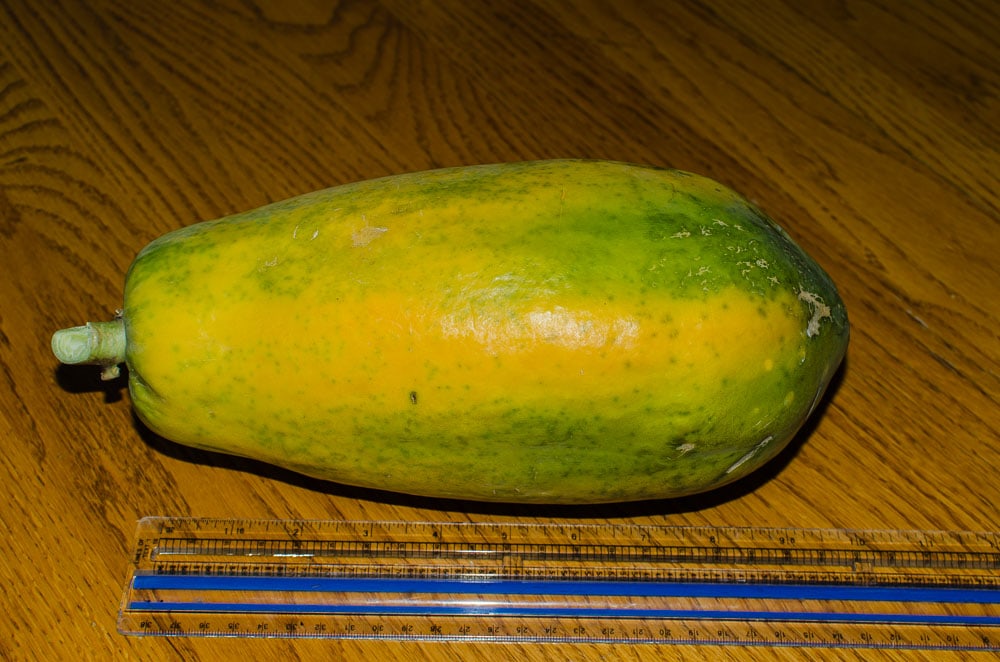
Growing Papayas in Texas Update: October 10th, 2020
Hurricane Delta wind damaged my trees a bit, but they are still producing ripe fruit. Pretty soon I am going to be overwhelmed. I need to start making jam and donate some to family, friends and neighbors.

Stay tuned for more updates on growing papayas in Texas.
Thanks for sharing your experiences! With luck, we hope to build a high tunnel and start growing papayas in containers. There is not very much information available on doing this in the States. With luck we can close off the ends of the high tunnel and make it through the freezes here in Bacliff, Texas.
Glad it helped. With no freezes you’ll get a lot of good fruit!
Do you keep the papaya leaves. I am looking for some to buy. There’s emerging info about medicinal uses.
I leave them on the tree. If you want some, trying just growing a few plants. The grow quickly and readily with seeds from store bought fruit.
Can you grow them in a pot? I grow my citrus in a pot and move to the greenhouse for the winter…
Never tried it but I also have a lime tree in a large pot and it does well. Try it!
Richard, sorry to hear about the fate of the Papaya trees from the freezing weather we had in February. Endeavour to persevere! and I am glad to hear that you are starting over.
I am about to start this project myself. I have a Brazilian wife who grew up in Belem where papaya grows on the streets and is known as the City of Papaya. We have tried acai unsuccessfully and now I want to try papaya. If I find a Royal Star papaya at my local HEB and harvest the seeds in May of this year, will I have an opportunity to bear fruit in 2022? I am located in Houston and would start them here but once large enough, I would transplant these papaya trees to some property in Wharton County (SW of Houston).
Thank you!
Yes, If you start them now you will surely get fruit in 2022…..as long as we don’t get a freeze!
I have 3 papaya trees planted by birds? Deer poop? Didn’t know what they were til I did a plant id!! And the deer dont seem to bother them and they normally eat everything!!! They are in a fairy shaded area of our yard here in boerne texas (hill country north of San Antonio). Should I leave them in the ground where they were “planted” or put into large pot to come into protection when we have freezes? Or should I just let nature donors thing? If they survive they survive?
Are you positive they are papayas? if so.. they won’t survive a freeze and they don’t transplant real well but you could give it a try.
I’m North of Houston and the cold weather is arriving. I have a nursery bought tree, about 5 ft tall now, it’s grown a good 12″ since I planted it in October. What would be a basic protective structure to survive low 30’s weather? Can I cover it with plastic or would it need a source of warmth? And thank you – I’ve learned quite a bit from reading your post.
If you put a work light under a plastic covering that will help. Good luck!
Just an update.
There are now 4 developing fruits on my daughter’s tree. So it’s a hermaphrodite which is great.
I hope that it can withstand Winter temperatures but it helps in that it’s fairly enclosed by a 6ft hedge.
I also encourage everyone to plant a papaya or 2. The one I got was about 5ft tall and $20. It was from a Houston nursery.
Hopefully it is a hermaphrodite, however females will produce fruit without being fertilized. The flower morphology can solve that question. Post a link to a picture of the flowers if you can. Good luck!
I have one 2-3 foot plant that is in a pot in the garden. I am located north of Houston. I plan to carry it to the garage when temps are low and plant it in the garden after the last frost in 2021. How does that sound? Seems I am close to where you are as you described your coastal location.
Enjoyed your plant journey, well documented and great images.
Thank you,
Jude Kirkeeide
Sounds like a good plan. Be careful in the spring when you transplant to your garden. Papaya trees a sensitive to root disturbance when replanting.Try to get it as much sun and warmth through the winter too. Don’t expect to see a lot of growth unless we have some warm days/weeks. Good luck!
Thank you for writing this and the regular updates. I planted a papaya plant ( as an experiment ) at my daughter’s in May 2020 that now has plenty of flowers and a single fruit that is tiny and yellowing. Probably going to rot but we’ll soon see. Unfortunately the flowers seem all female when comparing to your pictures. The issue with that is that nobody is going to keep a male papaya in a residential area if there’s no fruit! On the other hand there’s hope because you have had fruit from a female.
Your best bet is to plant multiple plants. You should get some hermaphrodites and they will help pollinate the females. Good luck!
Ideally. But she’s in a townhome with no space for more. It’s wait and see for now…..and getting it through Winter for later
There is a interesting article about Mr Moy that worked at the botanical garden in San Antonio Texas. Mr Moy developed a hybrid of the Papayas from Mexico. I recently bought some seeds which I have planted. Anxiously waiting for them to sprout. Also waiting for my royal star papaya seeds to sprout. I bought this papaya at WalMart in Buda Texas. Delpha
Good luck on your endeavor! Keep them warm over the winter!
WOW! What a GREAT article on the Texas Papayas that you have grown!
So much information and SO helpful!!
We have only always eaten Papaya dried. However, We bought our first fresh Papaya this
week and I cut it to for a salad that I am putting together to go with our fresh grilled Salmon.
May this be the first of many papayas that you will grow!
Charlotte from Central East Texas
Glad it was of interest to you!
I bought an organic Royal Star Papaya at WalMart as I had read that they were very sweet. I was so disappointed on the lack of sweetness. I wanted to plant the seeds but ended up throwing away most of the fruit and all the seeds. I enjoyed your article and pictures. I live about 25 miles southwest of Austin so will have to put my seedling into the greenhouse real soon. I’ve been thinking about starting a Facebook group page about growing l papayas. Not sure if there would be much interested. Delpha
Sorry you didn’t get a sweet one. The seeds would have been OK though. Sometimes they are picked too green for shipping and they may not ripen properly. I have found that even when fully yellow a few more days of ripening improves the sweetness. If you live southwest of Austin, you will need to have seedlings inside before any freeze. If you have a greenhouse get them started now.
Your article is very informative! Thank you for the seed and flower pictures. I have a question i can’t seem to find the answer for: when should i start my papaya seeds? Is October too late?
It all depends on where you live and your winter temperatures. if you live in a place with no winter frost or freeze, start them anytime. If you do have a chance of frost or freeze you can start them in pots and bring them inside during the cold snap. Once the chance of freeze is over, get them in the ground as soon as possible.
Thanks for sharing. I’m definitely going to try this out someday
I am growing papaya here in Texas too. It’s getting bigger and I was thinking building a small green house for my babies. I love papayas, your info is very helpful.
Good day, this is an interesting read. I have looked up for someone from this website to contact because I have a little request from one of your images. I hope that you would get this comment. Thanks!
I sent you an e-mail
Where can I get royal star papaya seeds
Go to the supermarket and buy a nice ripe Royal Star. HEB in Texas and Kroger both carry this variety. There will be enough seeds for an orchard!
WalMart in Buda Texas carries royal star papaya. Non gmo is printed on the label. I saved seeds from the last one I bought and have planted most of the seeds. Tried several different methods to see what works best for me.
I have spent hours on YouTube viewing videos on growing papayas and I unquestionably learnt more from the 20 mins reading your article. Excellent work and sincere thanks for sharing your experience.
Did you know I fruitlessly search YouTube to find exactly what I just read?!
YouTube is full of videos showing people how to grow tiny seedlings from papaya seeds…so repetitive!
Where is the fruit?!
Great great post and I was so happy to read all of the updates and see how current they were! Thank you so much!
Really excited to see your results here. We would like to get started with growing some papaya. We are North Texas. I was wondering what sort of soil composition did you have and also, what did you do to protect from the cold snaps? I am guessing the light and sheet helped maintain a stable temperature in the evenings? Do you think a burlap wrap with straw would maintain the temperature sufficiently or does it really need artificial heat to keep the temp up? Thanks for such an inspiring article!
The only soil amendments I made were to raise a small mound with some garden soil. I really doubt the climate in North Texas will allow you to grow these tropicals without some sort of “greenhouse” protection. Even here is a very marginal place to grow papaya. Sometimes you can get through a winter and sometimes not. A hard freeze will kill these trees.
This is great! I would love to try one!
Nice work. I live in Philippines where there is no problem with temperature….but there can be big problems with white fungus climbing the trunk and choking the tree to death…maybe less so if getting enough sun. Also people tend to harvest them green and let them ripen indoors to avoid insects eating the fruit. I prefer the yellow varieties for a natural constipation therapy …but the big one’s with red interior are easy to find.. Many Asians are superstitious that papaya decreases the sex drive. Not sure why…One discussion suggested it was because papaya is a ‘meat softener’?? Maybe that keeps the prices low here even they are delicious and great nutrition.
Awesome! Thanks for sharing.
You’re welcome!